The Indian Summer extended into August, really most unseasonable, the only usual weather pattern was gusty, windy days.
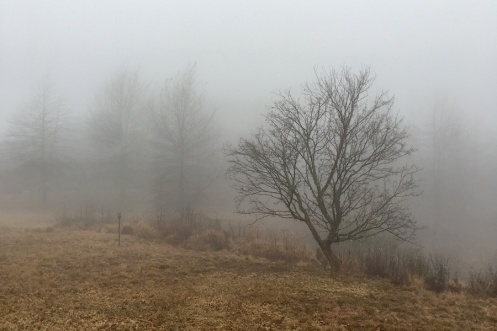
Two days were cooler, the 9th and 12th with misty conditions, 3C was the lowest temperature, but the average high was 21C with the highest day time recorded 26C. Only slightly more rain, 2.5mm was measured and the exposed ground is either cracking or dusty. There were no snowfalls to be seen on the Southern Drakensberg.
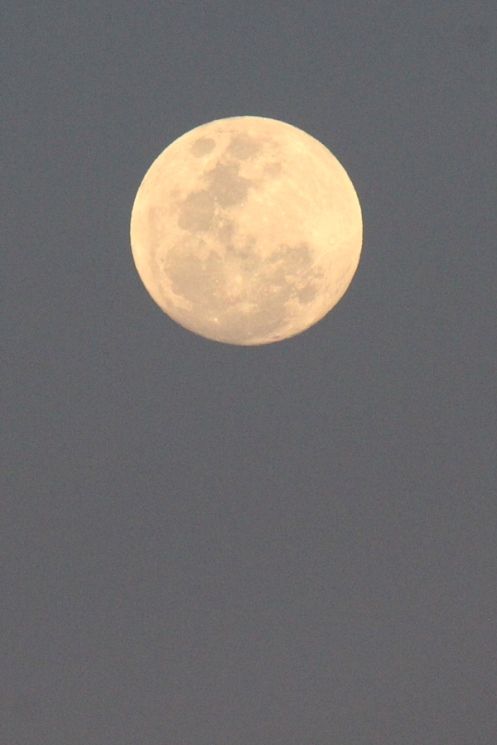
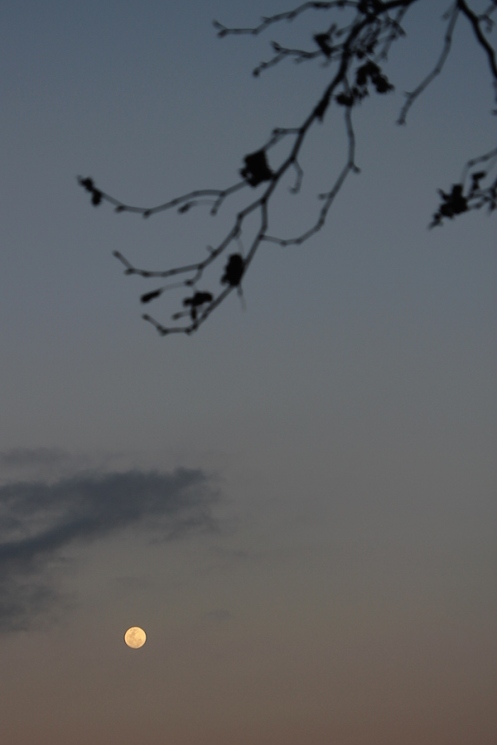
A beautiful Full Moon rising on the 15th .
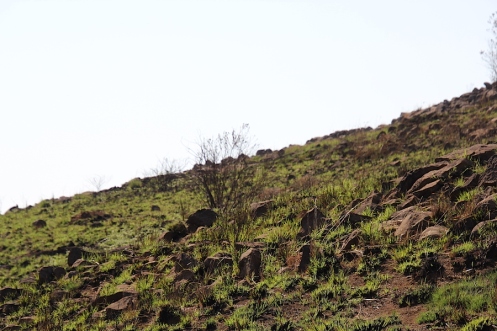
Despite the very dry conditions the hillsides are greening.
Not many spring flowers have yet appeared, however there are some bright spots.
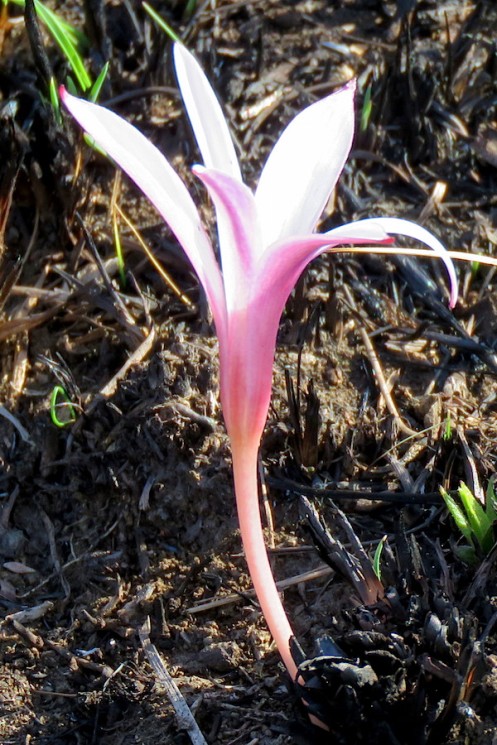
One of my favourite, scented flowers Apodolirion buchananii waved cheery small flags.

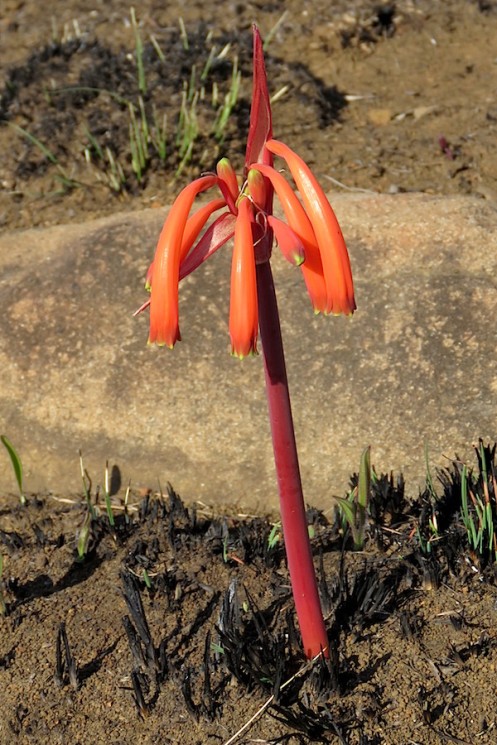
Bright red Green-tipped Fire-lilies, Cyrtanthus tuckii, appeared in burnt off areas.

Gazania krebsiana are flowering singly and in clumps.

A few tiny Hypoxis sp. dot the bare earth.
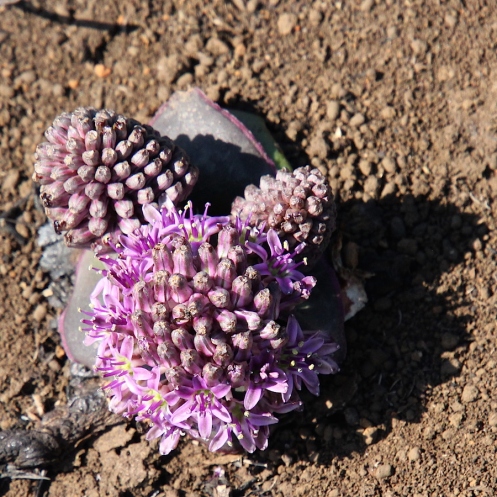
Many Ledebouria ovatifolia plants are in bloom.

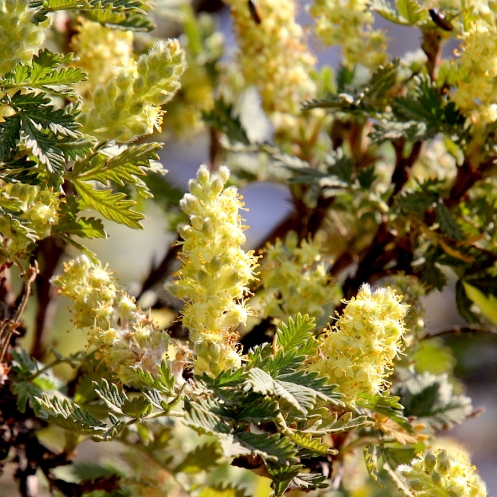
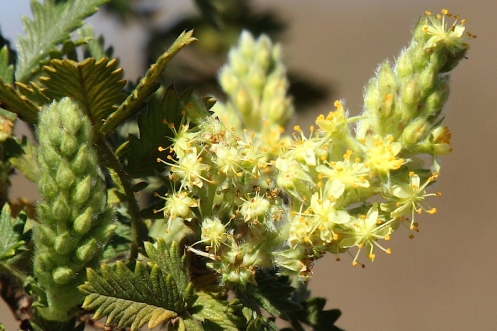
Perhaps the most obvious reminder that the season is changing is the prolifically flowering Ouhout, Leucosidea sericea.
I love the delicate Urginea species, and August is their time for blossoming.
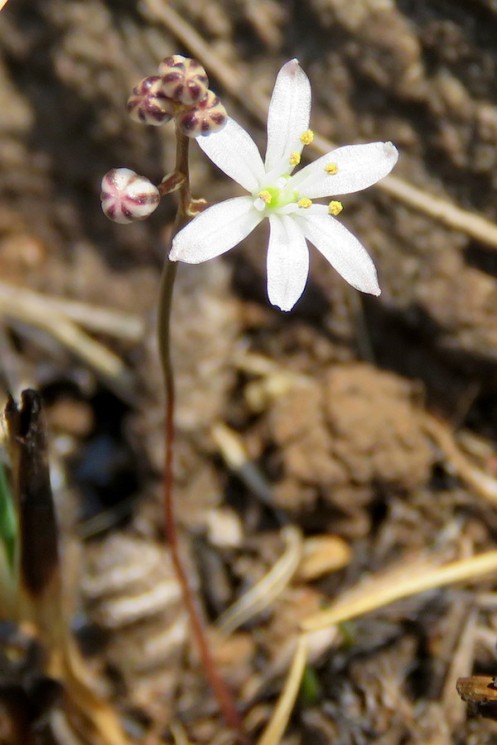
A really minute species, the flowers less than 5mm in diameter, and particularly difficult to photograph is what I think is Urginea calcarata, this is the first time I’ve managed a reasonable photo over the years!
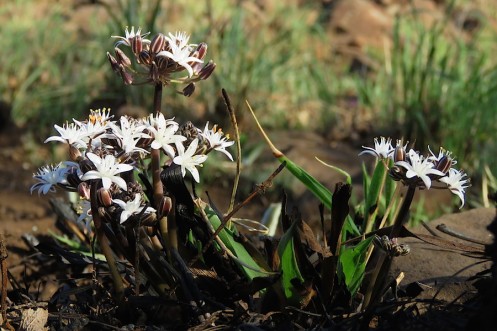

Urginea capitata has crowded inflorescences creating little bouquets.
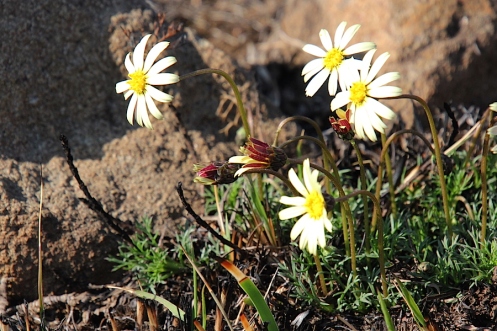
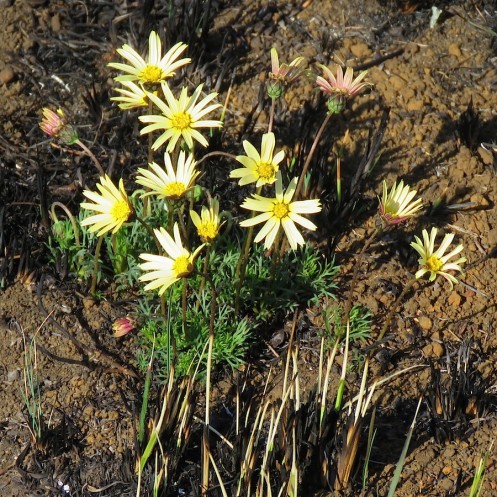
Many clumps of Ursinia tenuiloba are covered with vibrant pale yellow flowers.
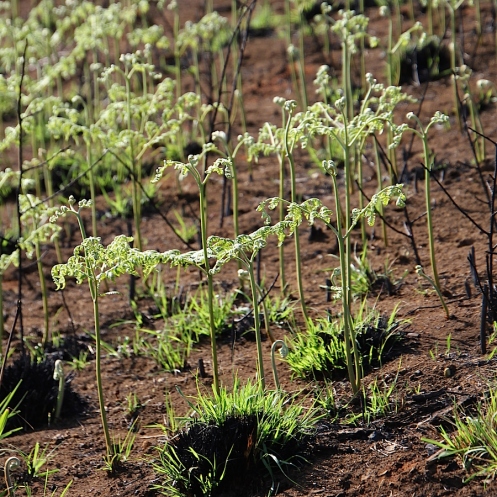
Graceful green Bracken fronds, Pteridium aquilinum, have started unfurling.
Earlier in August I really didn’t think many Orchids would appear,

however Eulophia hian var. hians,


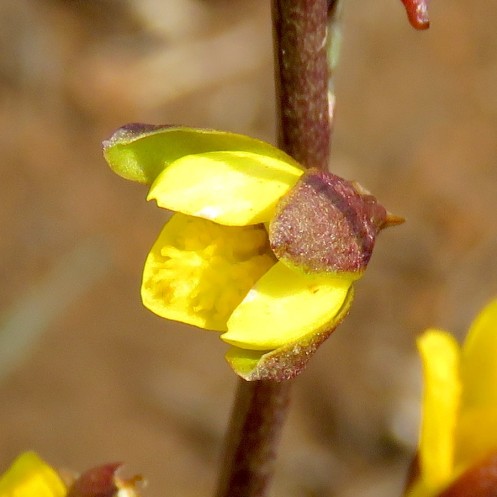
Eulophia hians var. inaequalis and
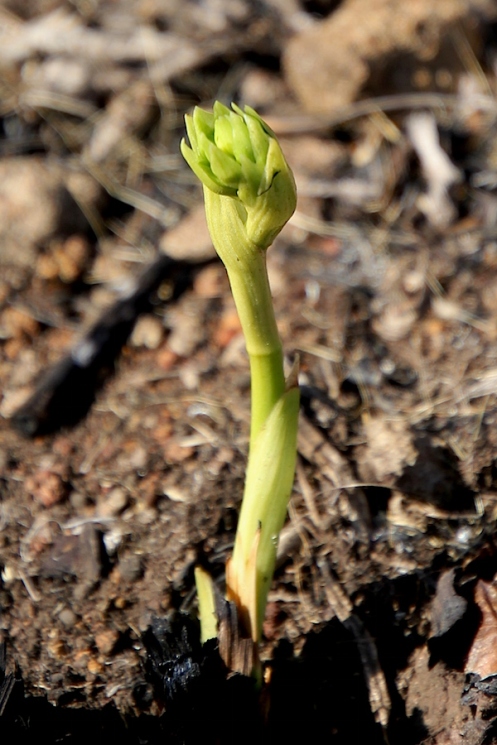
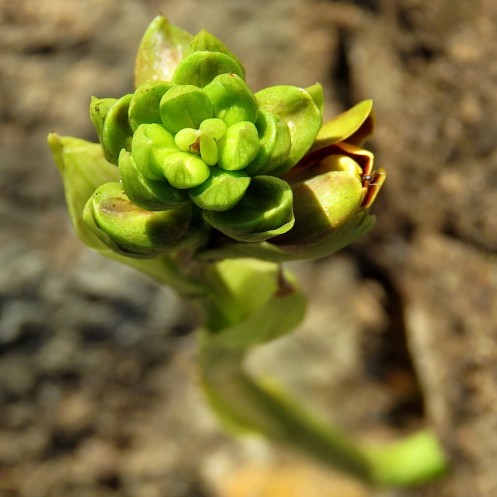
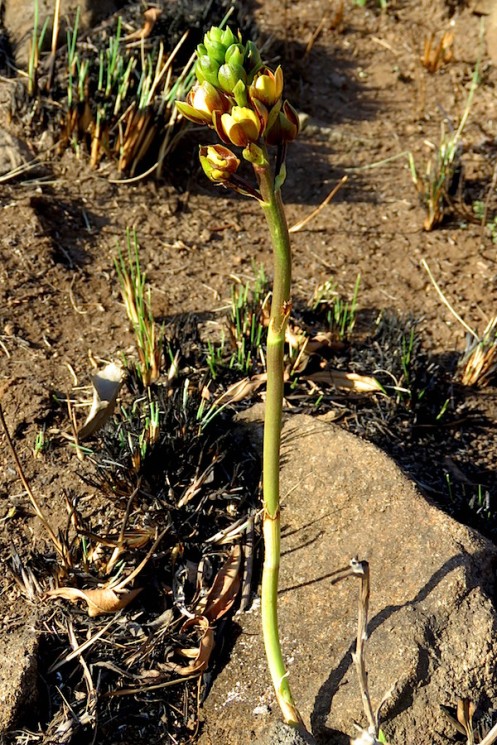
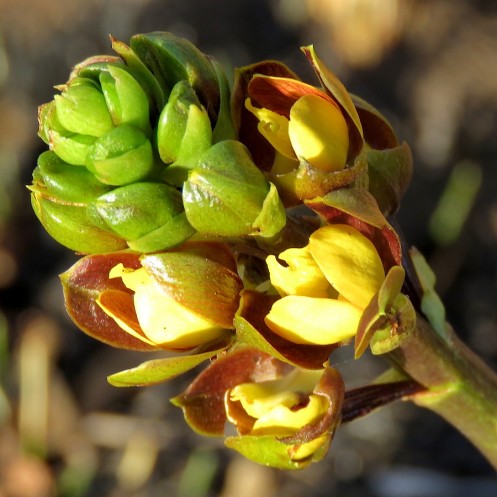
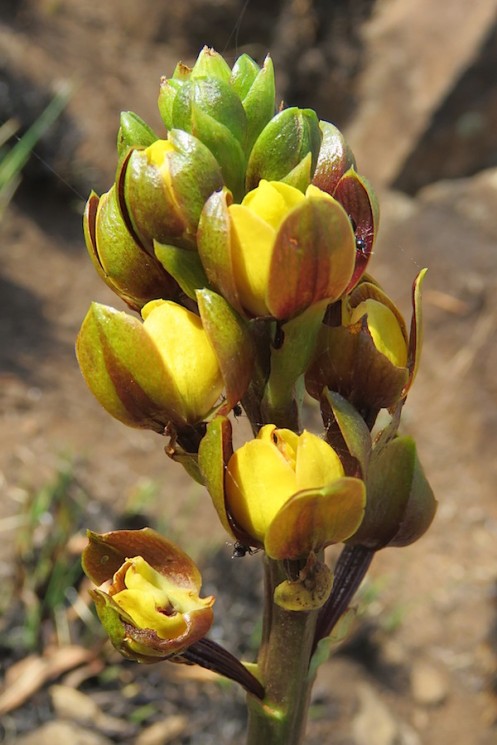
Eulophia parviflora (short-spurred form), have flowered.
Where flowers are blooming, particularly in the Buddleja salviifolia, Leucosidea sericea, Ursinia tenuiloba and Gazania krebsiana there are feeding insects!

Bee on Buddleja salviifolia.
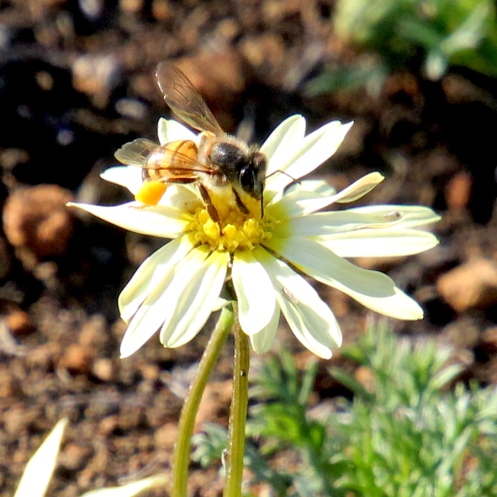
Bee on Ursinia tenuiloba.

Drone Fly Bee-mimic on Buddleja salviifolia.
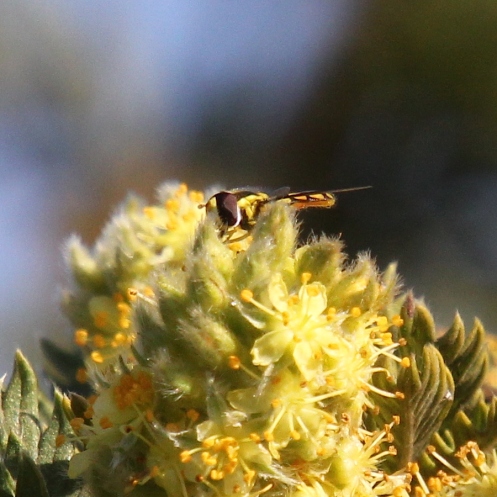
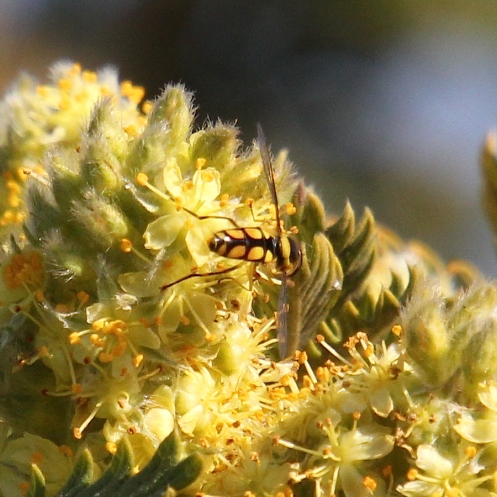
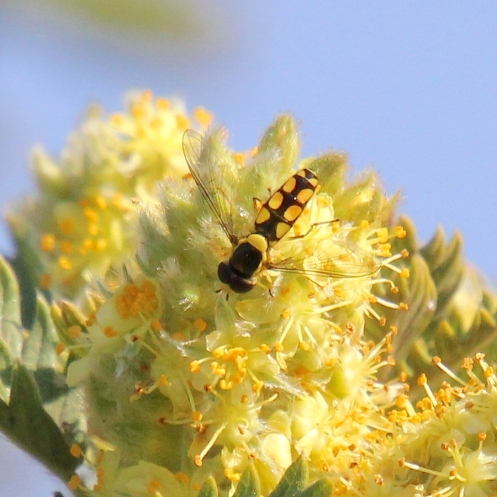
I watched this Hover Fly on Leucosidea sericea for some time, very busy,
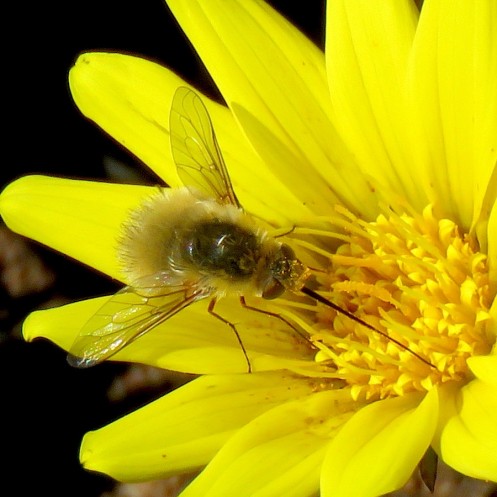
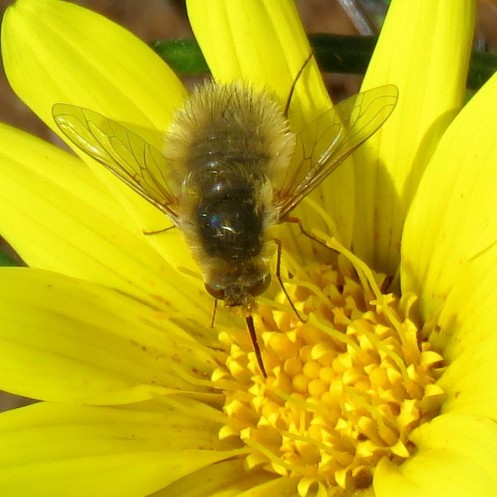
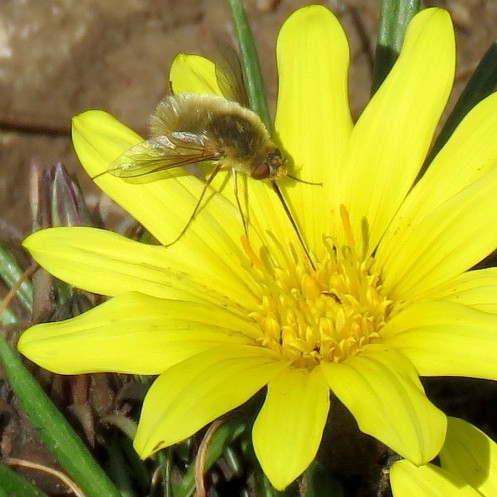
as well as a Woolly bee fly Systoechus sp. on Gazania krebsiana.

A very tattered winter form of Gaudy Commodore, Junonia actavia, enjoyed a sunlit rock.
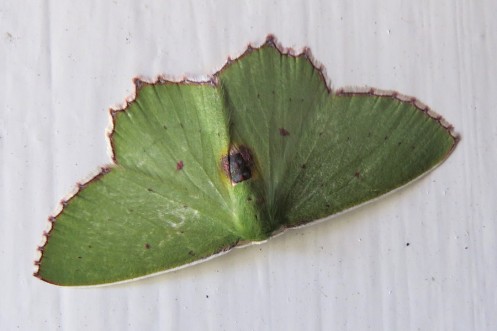
A leaf green moth, an Emerald sp. found on the kitchen door.
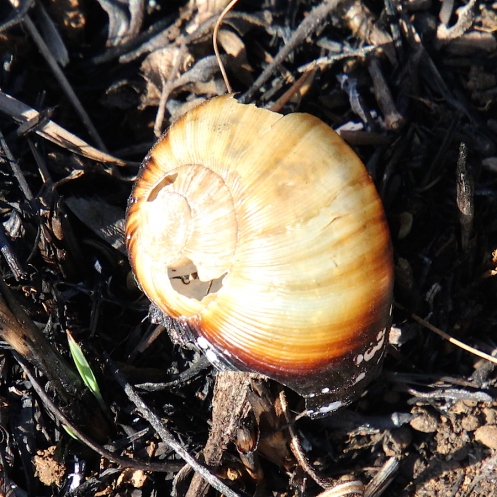
On a walk over the hillside I found an empty shell of a Common Cannibal snail, Natalina cafra, that had succumbed to fire.

Early one evening I surprised a group of three Common Reedbuck. They and the Grey Duikers are loving the new grass and are seen regularly grazing on the hillside. The Black-backed Jackals have been very vocal, evenings and early mornings.
The two birdbaths we keep topped up with water attract a flow of birds, to bathe and drink, Olive Thrushes, Cape Robin-Chats, Cape White-eyes, Dark-capped Bulbuls, Southern Boubous, Red-winged Starlings and the Black-backed Puffbacks.


One afternoon I saw the male and female African Stonechats on one of their favourite perches overlooking the valley below.
The Indian Summer extended into July, we had only two really frosty mornings after dry cold fronts passed over, the coldest morning was -1C on the 20th and a very balmy high of 26C on the 15th , only 0.5mm of rain for the whole month and that was during the night of the 31st.
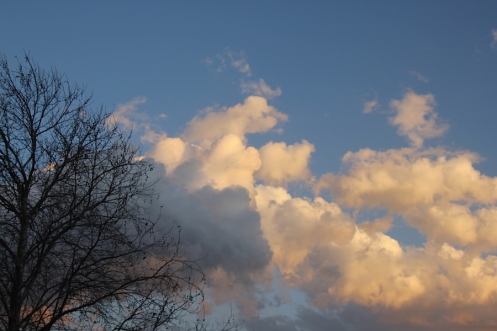
Billowing clouds on the 1st didn’t come to anything.
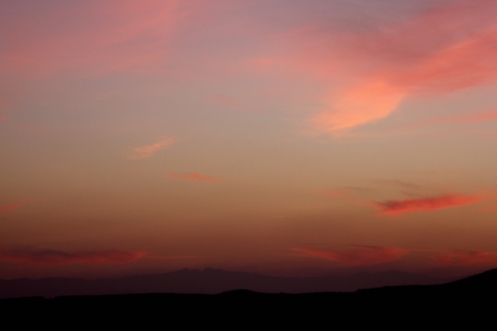
July is fire month, controlled firebreaks are burnt off and there is an ever present anxiety in the dry conditions that a fire might come through before they are completed. As a result there were some stunning smoky sunsets.

Photograph by Philip Grant
Our controlled firebreaks were done on the 16th
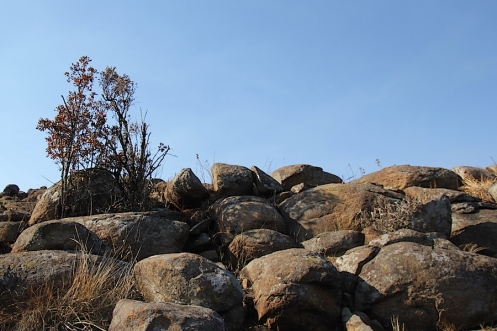
leaving behind blackened hillsides.
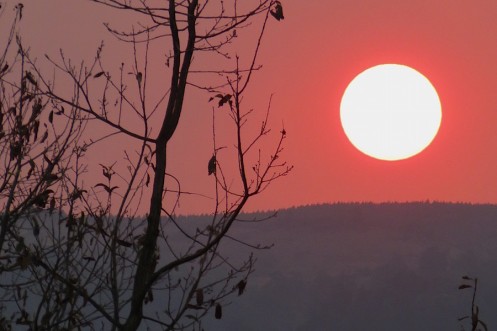
Sunset on the last day of July.
Despite the burning, some flowers survived,

in fact some Aloe maculata plants have sent up new buds!
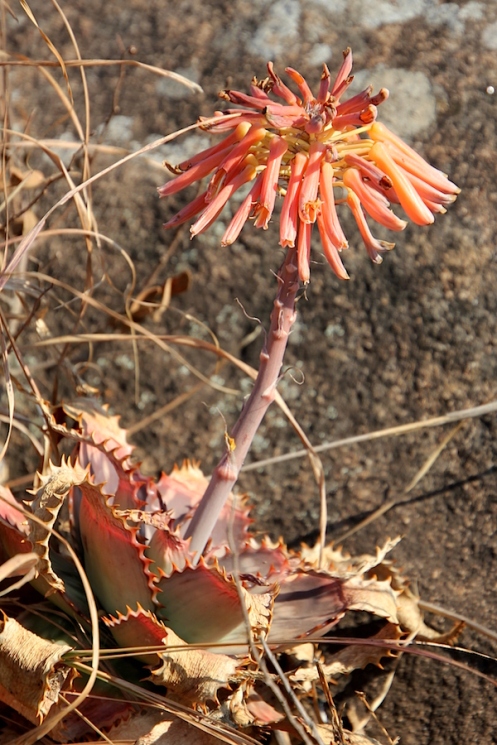
Aloe maculata
In burnt areas despite the dry soil, leaves are starting to emerge
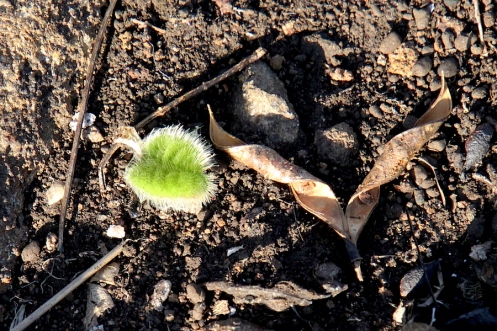
like this tiny Berkheya setifera.
Winter is made complete by clouds of flowering inflorescences on the

Buddleja salvifolia bushes. We have cream and a pale lilac forms,
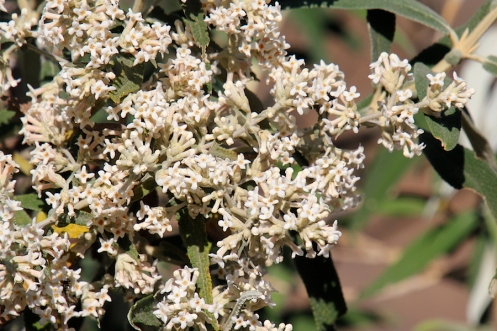
Buddleja salvifolia cream form,

Buddleja salvifolia pale lilac form,
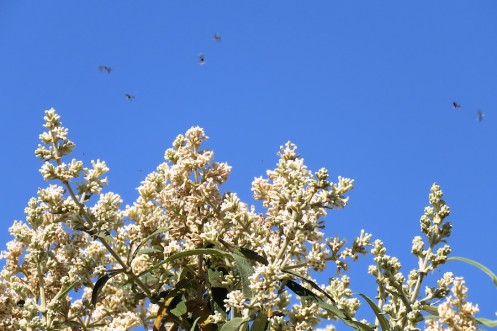
the heady scent wafts in waves and attracts myriads of insects.
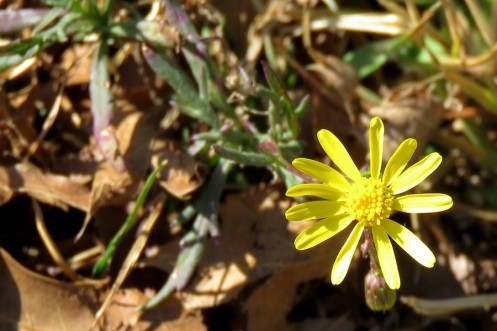
The yellow Euryops laxus flowers shine in the dry grass.
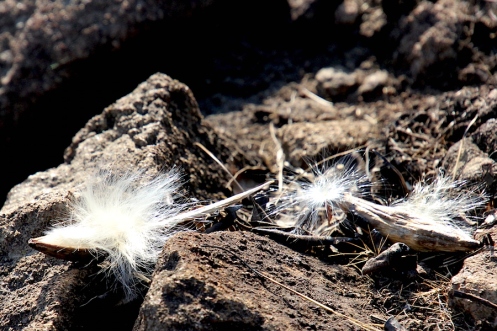
Amongst the burnt area I found this seed capsule of a Pachycarpus natalensis split open.
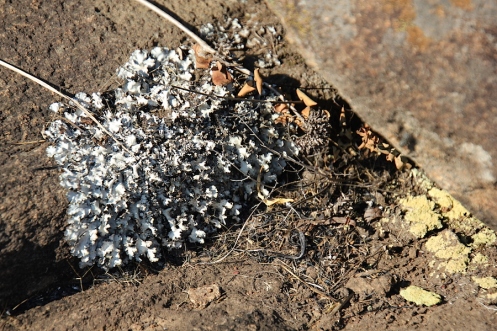
Incredibly Ascomycota (sac fungi), Foliose lichen also survived the flames.
Birds have been very active, particularly visiting the two birdbaths we kept topped up with water. Cape Robin-Chats, Cape White-eyes, Dark-capped Bulbuls, Southern Boubous and the Black-backed Puffback are often seen together as they drink and splash.

Yellow-fronted Canary
and Cape Canaries are also frequent visitors. The pair of Amethyst Sunbirds are a delight as the flit amongst the few available flowering plants. I have heard a Fish Eagle calling from the valley below and on two occasions heard an owl hooting in the early mornings.
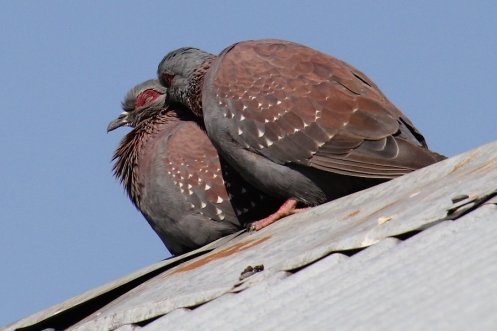
The resident Speckled Pigeons take every opportunity to sun themselves on the roof, contentedly cooing.
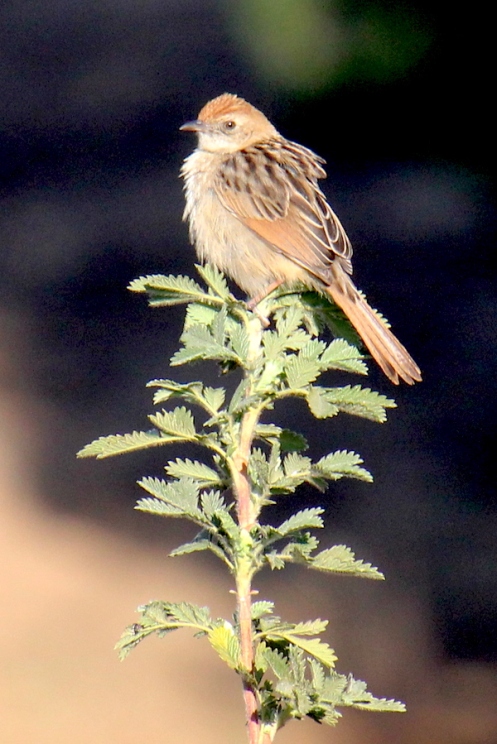

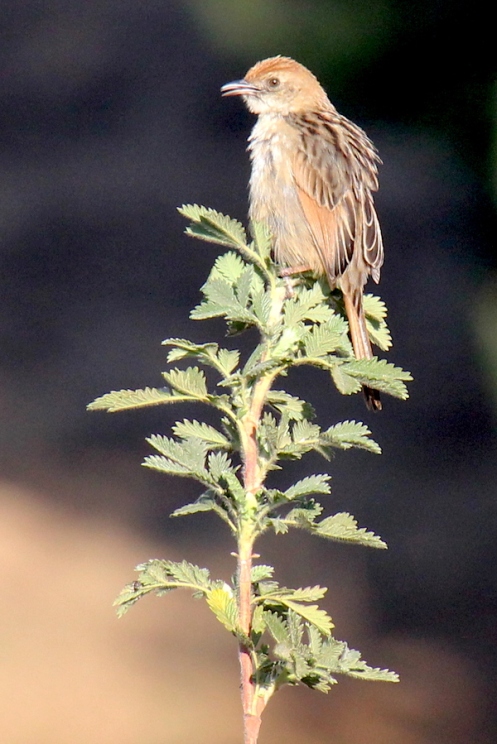
One morning I watched a Wailing Cisticola basking and preening in the sun.
Apart from frenetic ant activity,

I saw this fly resting

and this lovely moth in the sink.
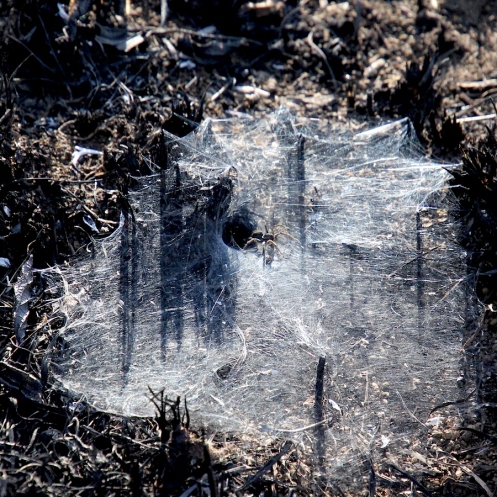
A Grass funnel-web spider waiting in its carefully reconstructed web in the ashes caught my eye.

I wasn’t quick enough to photograph a snake quickly slithering backwards into this hole. It had been sunning itself, then realized I was too close. I think it was a Rhombic Night Adder. Although I waited motionless for about 10 minutes it didn’t reappear.
Duiker and Reedbuck come regularly to feed near the house in the early morning or evening. Black-backed Jackal can be heard calling most nights.
Golden yellow and orange with blue skies defines June, which as usual experienced stunning weather, cool to mild, with sunny skies. The coldest day was just after a cold front passed over on the 11th, yielding only 2mm of rain, but a frosty day on the 13th after the clouds had cleared, with a low of 1 and high of 6 degrees Celcius.
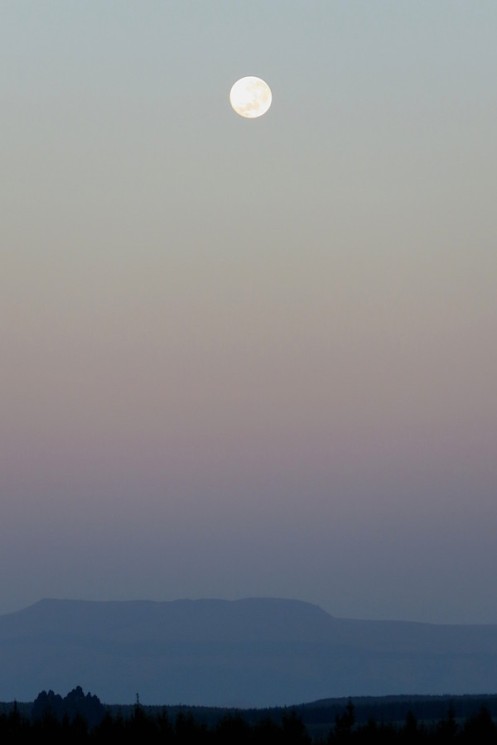
Full moon on the 17th was stunning and still picture perfect the following morning.
Although there were few flowers in bloom some of the seed heads from the summer still persist and add to the winter atmosphere,

such as these Agapanthus campanulatus seeds.
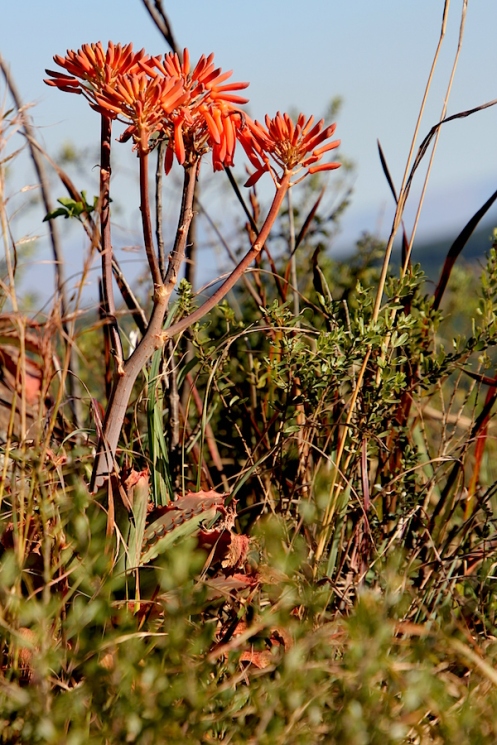

Aloe maculata create bright orange spots of colour on the hillside.
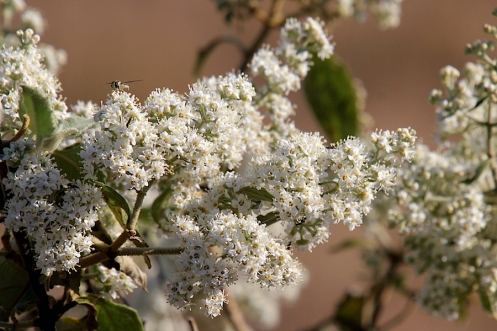
Dainty Buddleja dysophylla are my special June flowers, seen here with a Hover Fly feeding from the blossom.
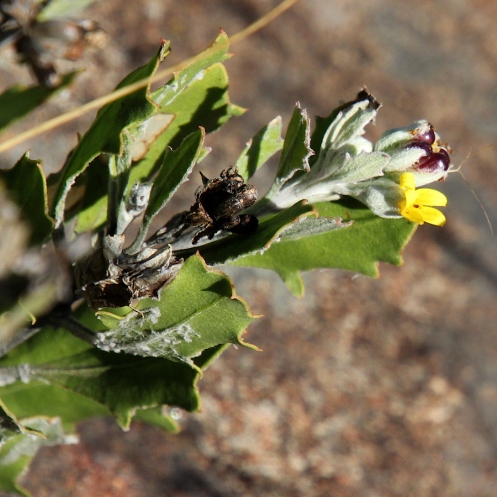
Chrysanthemoides monilifera subsp. canescens, Bush-tick berry, showing why they have their common name.
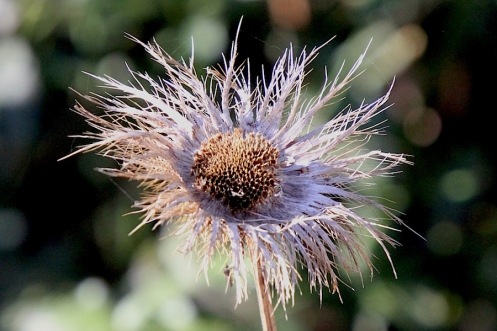
Berkheya setifera flower almost continually throughout the year, however at the moment only the stunningly intricate seed head remains.
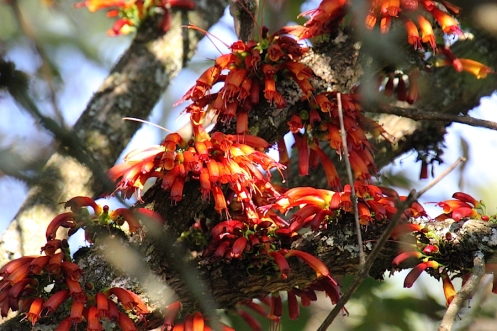
All the Halleria lucida, Tree Fuchsias are in full flower with the buzz of many attendant feeding insects and birds.

Helichrysum glomeratum and

Helichrysum umbraculigerum dried flower inflorescences add detail to the warm glow of winter grasses.

Rust coloured Watsonia socium seedheads stand out against frosted and bleached grass.

Some grasses still have seed heads, Aristida (possibly) junciformis and

an ethereal Melinis species.


Lichens decorate bared branches, incredibly varied and intricate forms.
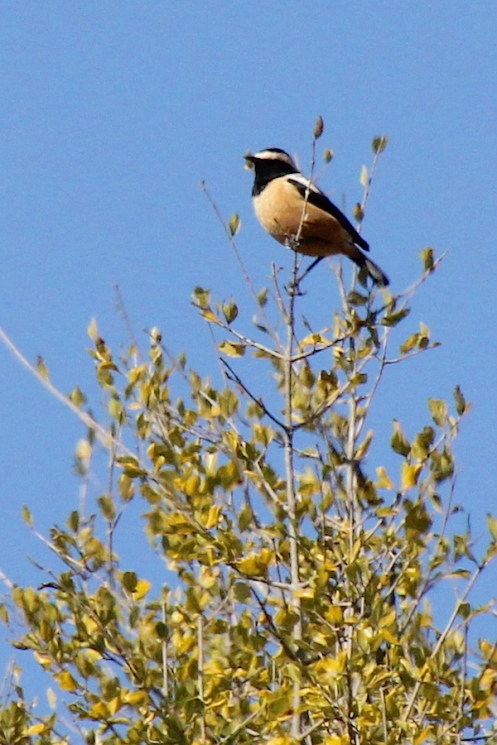
A male Buff-streaked Chat surveyed the rocky hillside while sunning himself.
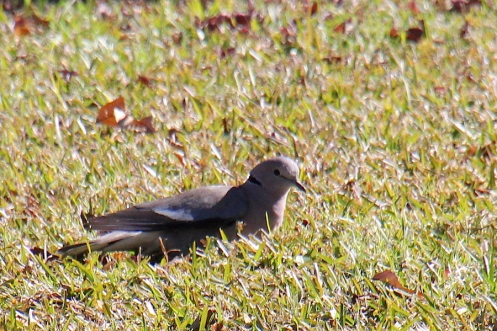
Usually we hear the cooing of the Cape Turtle-Doves more than we see them, however after the coldest nights they sunbask on the lawn.
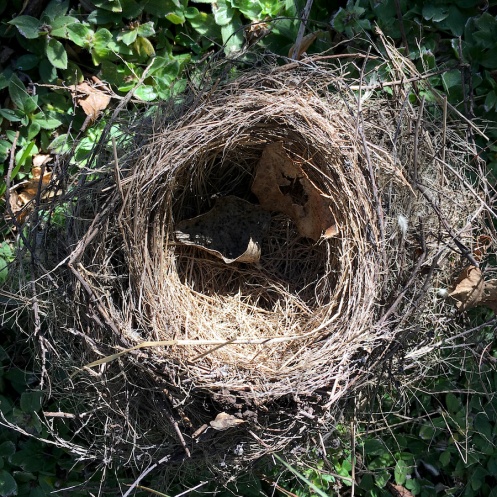
Under shrubbery I found this beautiful nest, most probably built and used last season by the pair of resident Southern Boubous, they are a common endemic species.
Not a great photo,

but still a wonderfully subtle patterned moth.

The colours of this Painted Lady, Cynthia cardui blended perfectly with the dry grass.
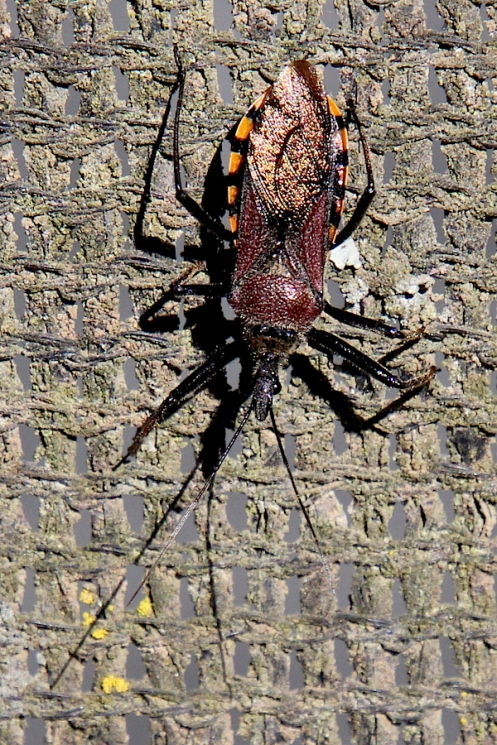
An amazing glittery bug, possibly a Flower Assassin, Rhinocoris species caught my eye.

This small, almost shrimp like insect with really long antenna intrigued me, a Wingless Meadow Katydid, Megalotheca species.


A slow walk over the hillside revealed this iridescent snake skin.
Duiker and Reedbuck come regularly to feed near the house in the early morning or evening. Black-backed Jackal can be heard calling most nights, and a very special sighting one morning from our bedroom window was a Caracal strolling up the track towards the top of the property.
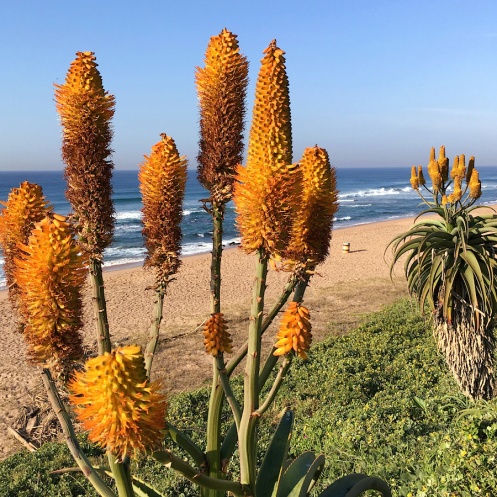
Sparkling sea sings an endless song
as waves come to shore
careless children with no purpose
armed with garish disposable plastic nets
pry and poke in rock pools
disrupting tranquil inhabitants
A young boy’s joy of a flitting yellow butterfly
severed by his mother’s intent
on a gadget monitored run
to achieve transient fitness
oblivious to the hum of bees in the
glowing aloe lined paved pathway
where the intricate beauty of a small caterpillar journey is unheeded
Malevolent Mordor monster machines
roar in a lava flow of
red tail lights to the horizon
rubber trail, oil, fumes and impersonal
glinting metal leviathans
etch into the landscape as darkness descends
We are all complicit in the destruction
Serene blue skies
white trailing high cloud
graced by a waning moon
a skein of birds fly through clear air
cool golden grass lies quiet on winter sunbathed hills
Gaia does not need this plague
a species driven by the apple
of oversaturated high definition unreality
dis-ease
We need to stop, take check and reconnect
realizing we cannot exist without her.
(Reflections the day after a trip to Durban, normally I focus on all the positive things I observe, however as darkness descended on the way home, thoughts of things I’d seen bubbled up. The day was actually a happy one, having a routine service done on our vehicle and spending time with treasured friends we’d not seen in many years.)
Very mild to warm, dry autumn days this May, so far no real frost. There was a light dusting of snow on the top of the southernmost part of Drakensberg on the 4th May in the early morning.
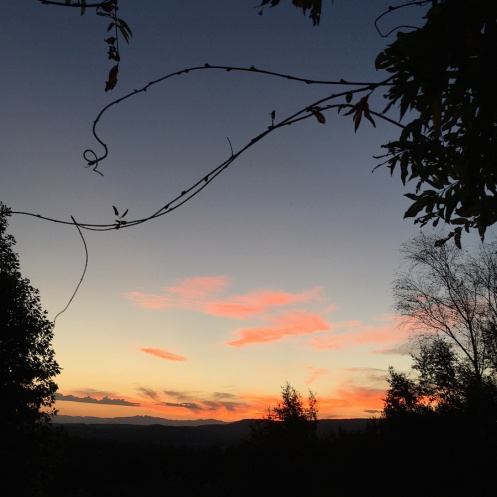
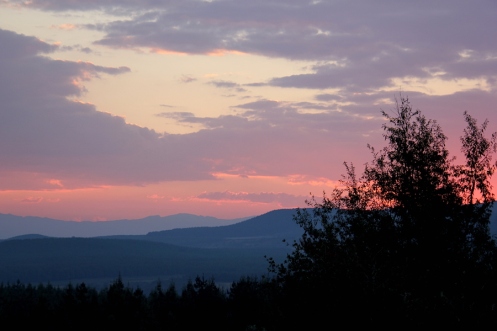
Often the sky was hazed by smoke from tracer burning creating lovely atmospheric sunrises and sunsets.
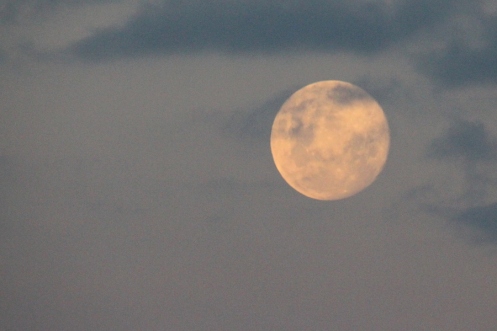
On the morning of the 18th May I drove to Underberg under a glorious full moon.
The total rainfall this month was 7.5mm, only two days when precipitation was recorded. The lowest and highest temperatures recorded were 5 and 25 degrees Celsius.
The birdlife here has been very active.
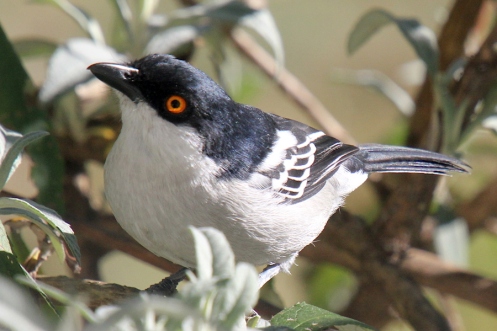
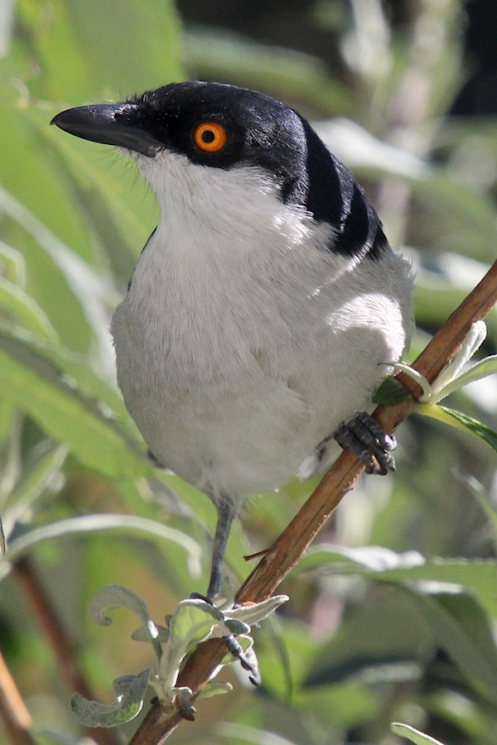
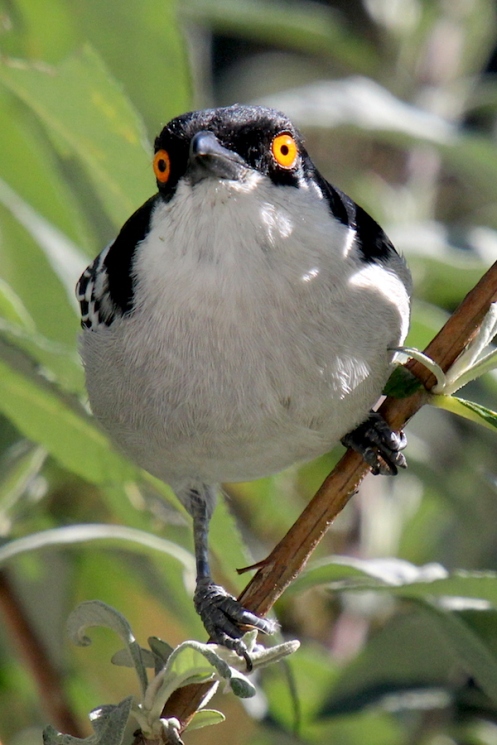
A male Black-backed Puffback was intent on seeing off the male rival reflection on the windowpane.
The Speckled Pigeons have been busy raising a late season brood of two juveniles.
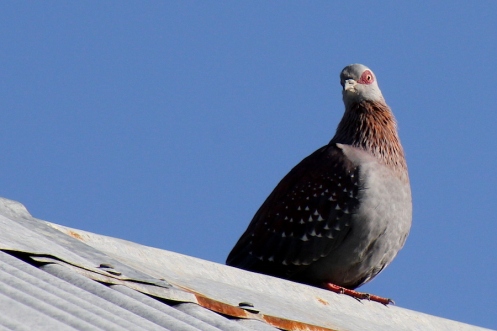
Adult Speckled Pigeon

Two juvenile Speckled Pigeons on the nest
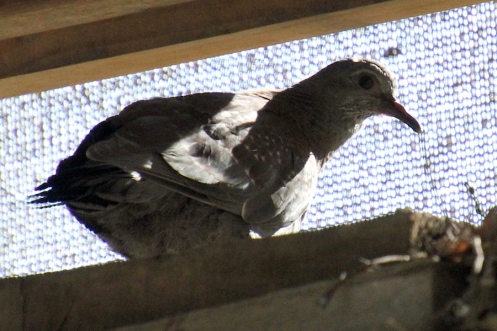
Juvenile Speckled Pigeon
One morning I heard the distinctive cackle of Green Wood-Hoopoes and saw them flying overhead, most evenings there is a fly past of a flock of Egyptian and Spurwing Geese. I saw an owl fly off in the headlights of my car one morning.
I noticed a few
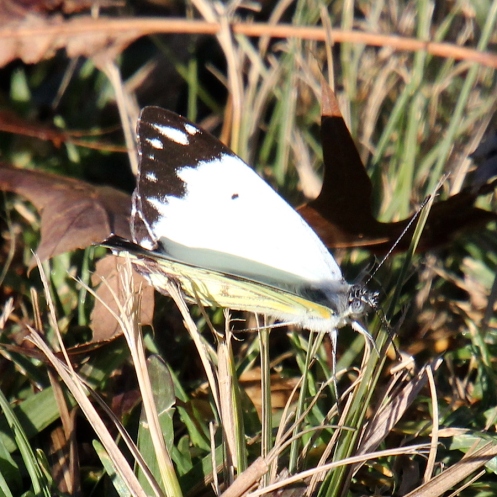
African Common White, Belenois creona severina
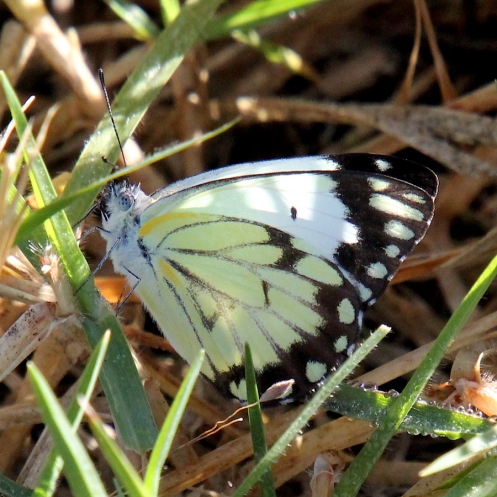
African Common White, Belenois creona severina foraging in sparse flowers.
One evening I spotted what is probably

a male Steatoda capensis spider
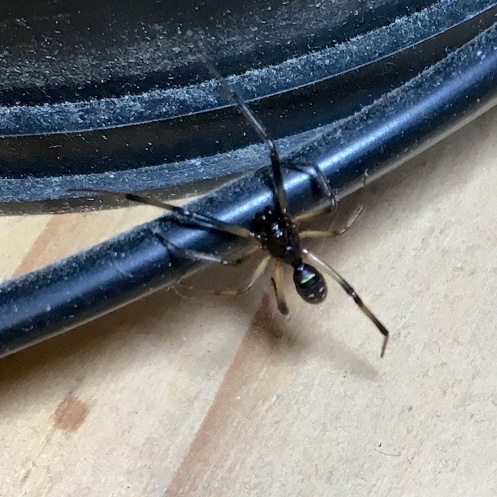
a male Steatoda capensis spider.
Very few flowers this May, however the
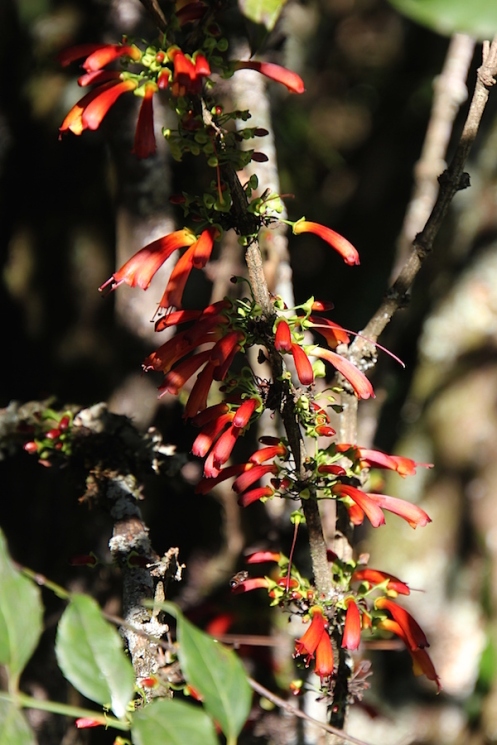
Halleria lucida have started flowering and there were a few
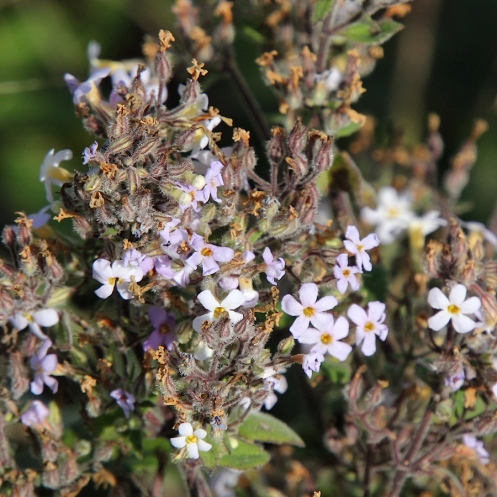
Sutera floribunda flowers.
Black-backed Jackals have been very vocal in the cool evenings.

There have been some dramatic spells of weather during April. On the 8th I drove through successive thunderstorms from Underberg, back home. Driving up Faber’s Hill was very slippery, the road was completely covered in hail. At home leaves and buds were stripped from trees and plants and the veggie garden was annihilated. Then although we were spared flooding, we had an unusually high rainfall starting on the 20th and finally clearing on the 24th, 68mm. The total rainfall this month was 133mm. The lowest and highest temperatures recorded were 8 and 25 degrees Celsius.
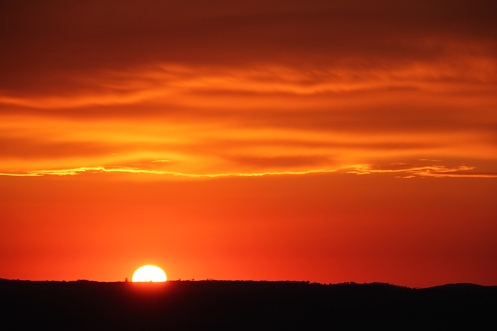

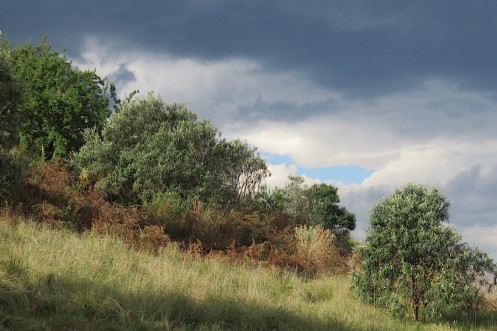
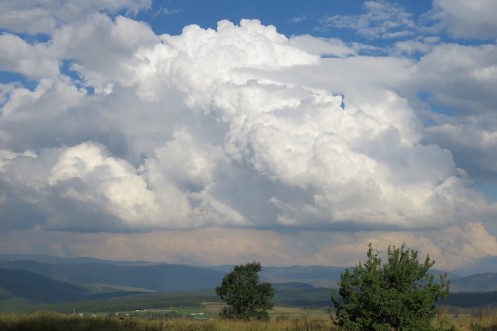
As a result of the variety of weather we had some stunning sky-scapes.
The rain and cool conditions were ideal for fungi and I saw 11 different species, though there were probably more!

Amanita rubescens;

Astraeus sp.;
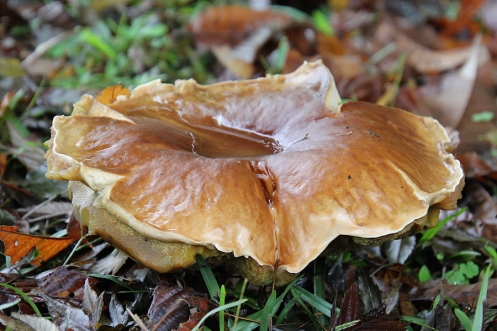

what I think is a type of Bolete;
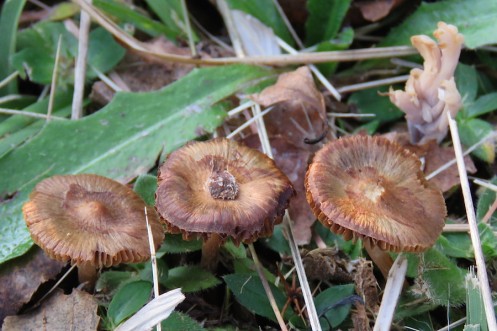
Crested Coral Fungus, Clavulina cristata on the top right of this image with as a yet unidentified mushrooms;
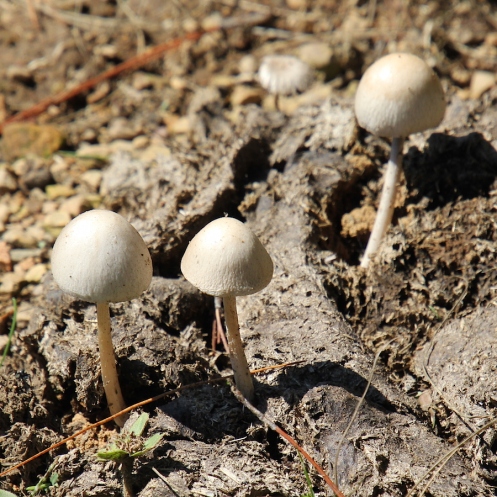
Dunce Cap, Conocybe tenera;
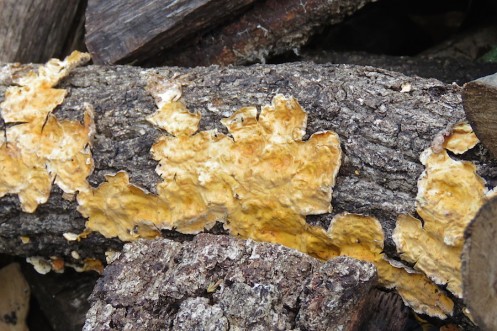
Hairy Crustcap, Stereum hirsutum;

I would love to know what this tiny mushroom is;
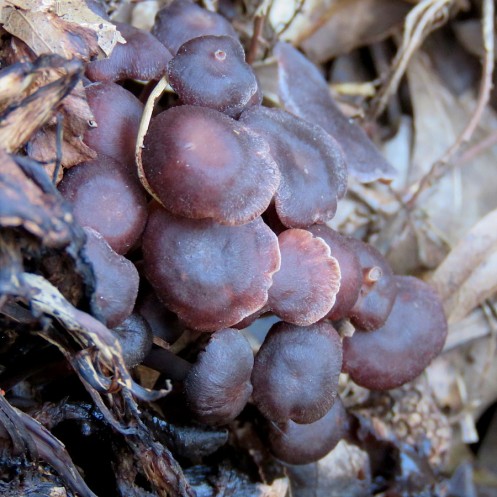
Lepista sordida;

Small Pine Cap, Gymnopilus penetrans;
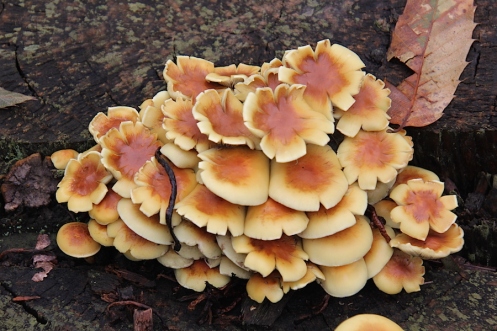
Sulfur Tuft, Hypholoma fasciculare and
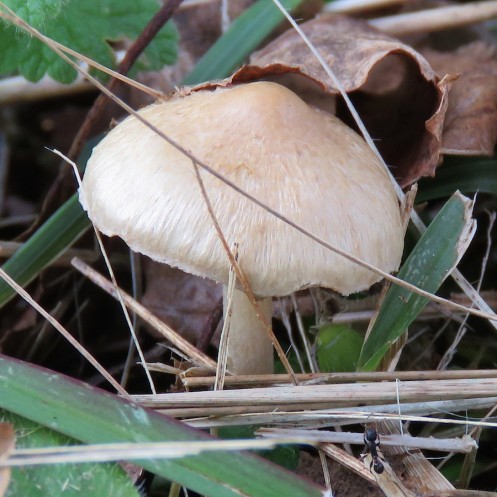
Umbo Toadstool, Incocybe eutheles.
Before plants were stripped by the hail I saw this
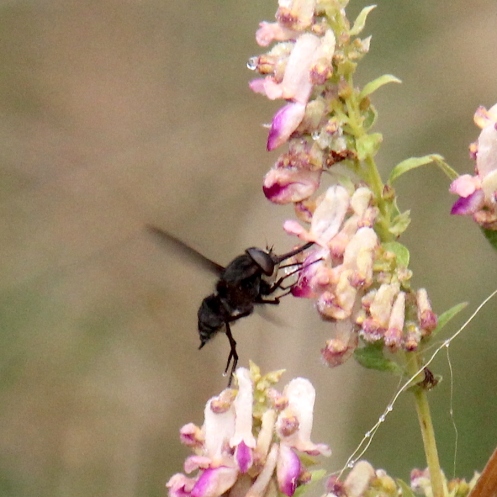
Fly, a Philoliche sp. feeding on Plectranthus calycina flowers;

an exoskeleton discarded by a Hopper;

a delightful tiny beetle and
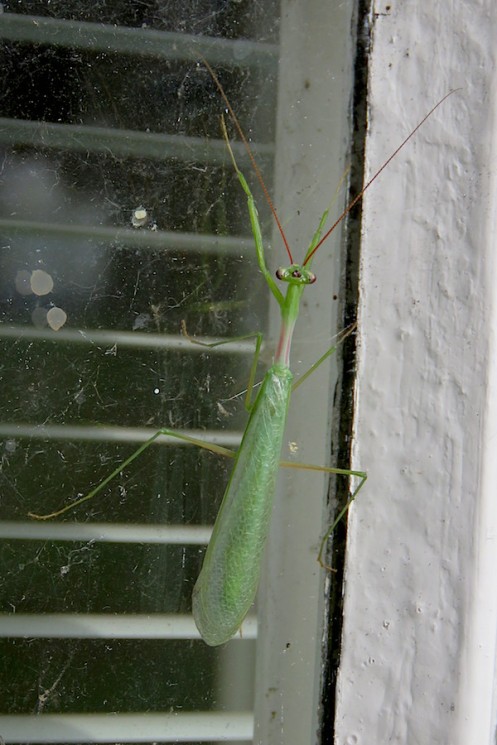
this elegant Mantid a Miomantis sp..
Although I have seen several butterflies I didn’t manage to photograph them, the exception was this rather poor image of an
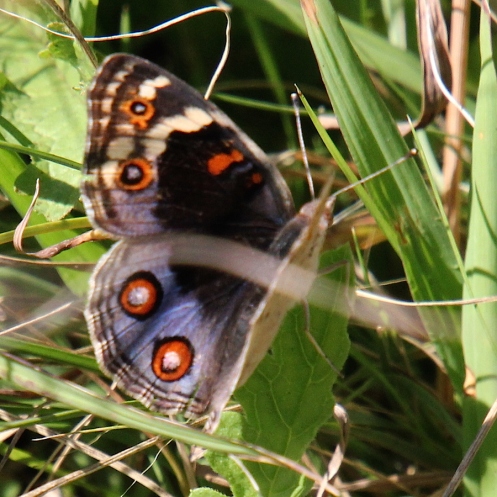
Eyed Pansy, Junonia orithya madagascariensis;
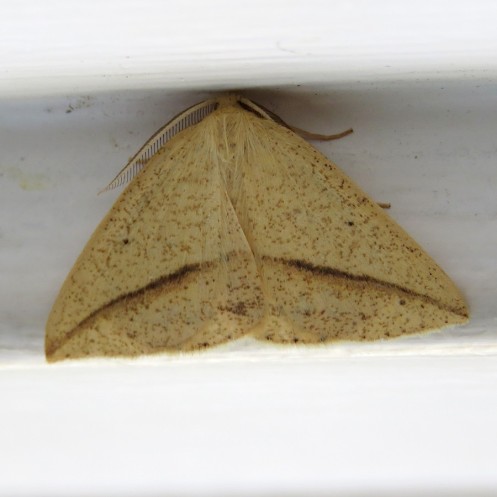

there have also still been several moths,
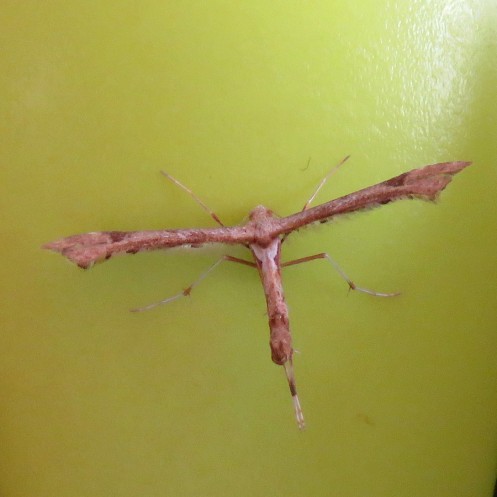
including this Orange Plume Moth, Crombrugghia wahlbergi.
On a wet morning
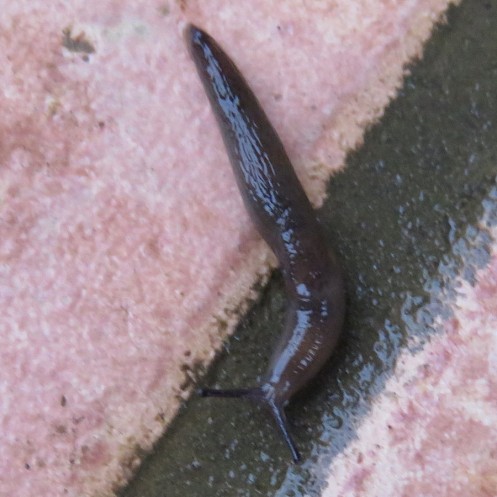
I spotted this tiny slug on the back doorstep.
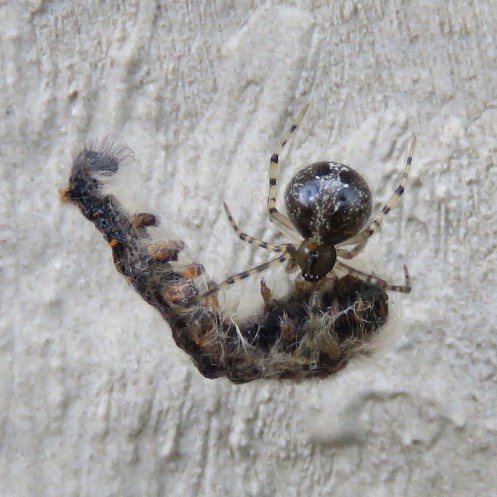
A False house button spider, Theridiidae theridion had caught and was trussing up a hairy caterpillar much larger than itself!

think this was a Cape White-eye nest.
We haven’t seen
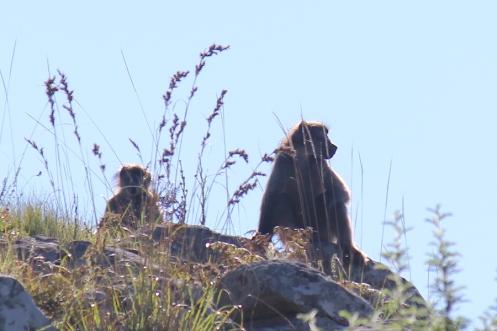
Baboons since March 2017, (this photo was taken then),
during the middle of the month a troop of about five individuals were around for a few days.
Twice an Eastern Green Snake, Philothammus occidentalis has come in doors briefly before going outside to glide up into the shrubbery, so lovely to see it!
The flowering plants were stripped by the hail, I did get a photo of
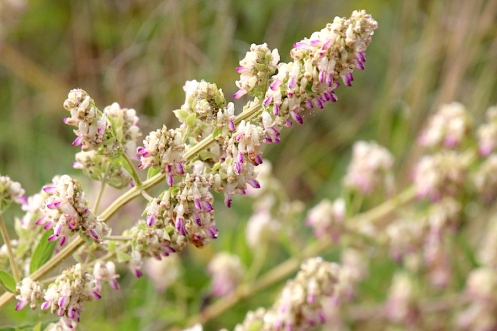
Plectranthus calycina
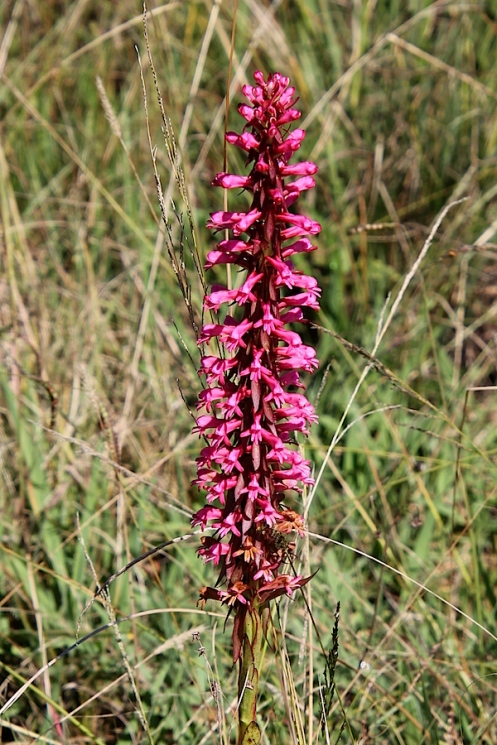
and a Satyrium macrophyllum prior to the storm.
In the last few days
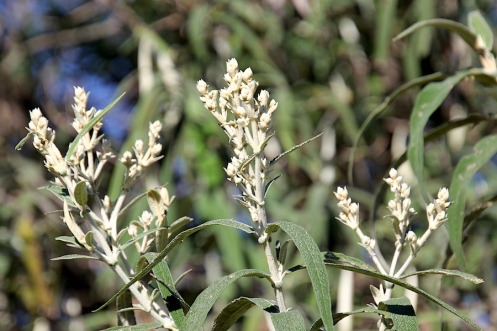
Buddleja salvifolia buds are starting to appear.
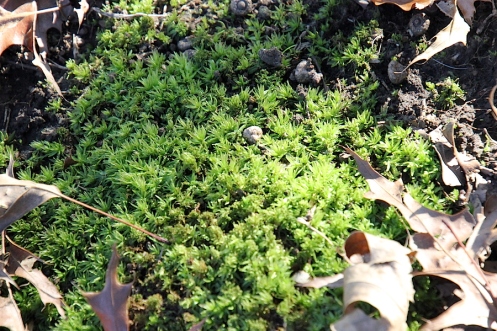
Moss has flourished is shady corners!
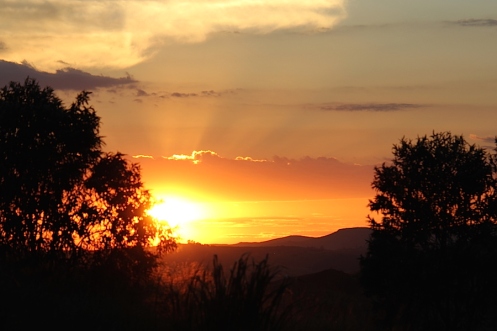
March has been milder, though there have been thunderstorms most evenings. Although there has been less rain fall this month, 116mm, there haven’t been long hot spells between, so the soil has remained moist. The lowest and highest temperatures recorded were 10 and 28 degrees Celsius.

In the mornings there is now a crispness in the air, the sun rises after 6am since the Autumn Equinox on 21 March, and the leaves on the exotic trees have started turning colour.
A first for me was finding

a caterpillar of the Gaudy Commodore, Precis octavia sesamus on one of its host plants, Plectranthus calycina. Throughout the year we see adult butterflies in their
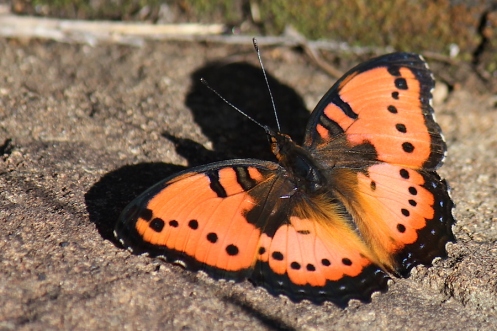
Gaudy Commodore, Precis octavia sesamus, summer form

Gaudy Commodore, Precis octavia sesamus, winter form; a visual delight, they are the butterflies of our home!

Another small butterfly seen on a Geranium schlechteri was of the Common Blue group of butterflies Leptotes sp., not certain which one.
As often happens in Autumn there have been many moths, ready to lay their eggs for the next Spring season;

Duster, Pingasa abyssinaria;
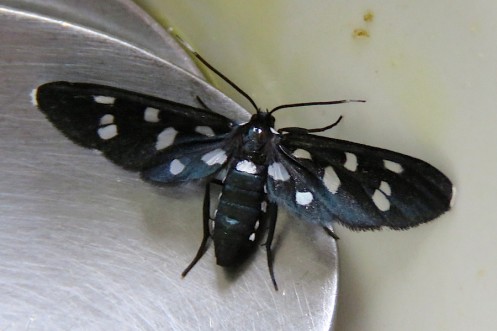
one of the Handmaidens moths, Family Ctenuchidae;



a few unidentified ones;
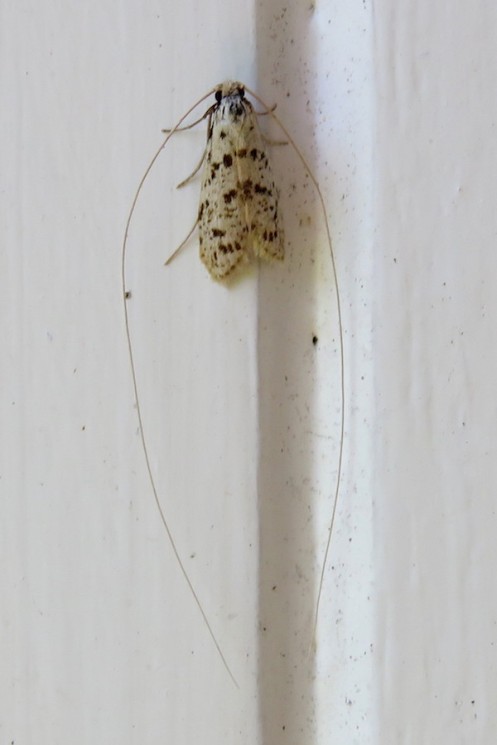
Longhorn moth, Family Adelidae;
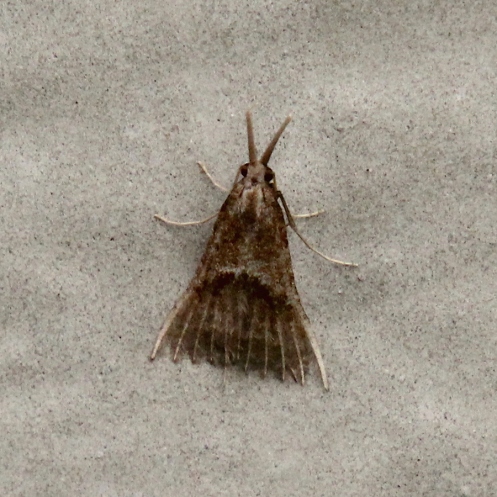
Many-plume moth, Family Alucitidae;

Pretoria Red Lines, Cyana pretoriae
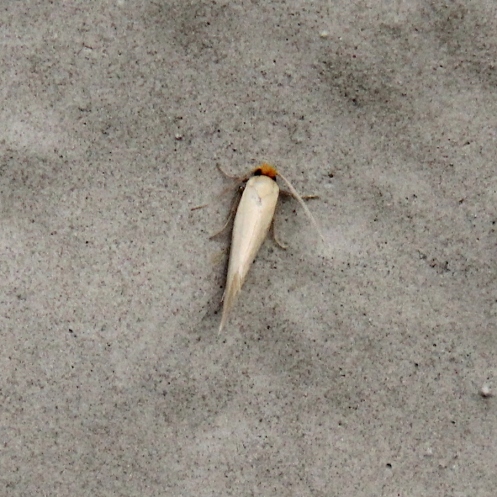
and the very small The Horn Moth, Ceratophaga vastella.
On my wanderings I discovered some lovely insects;
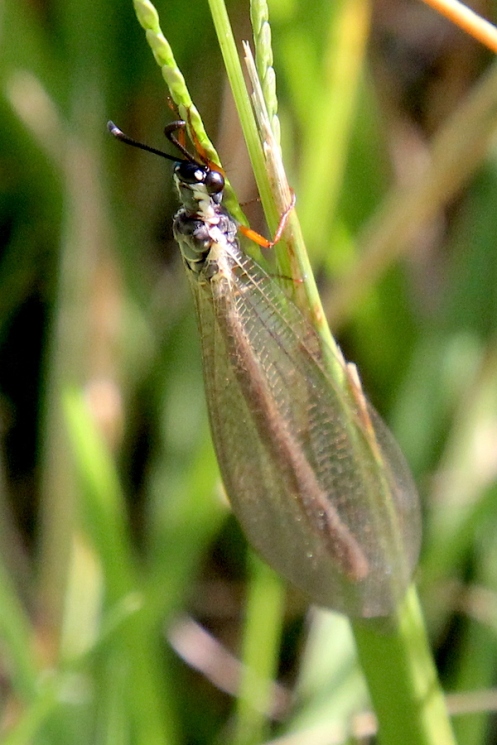
an Antlion, Hagenomia lethifer;
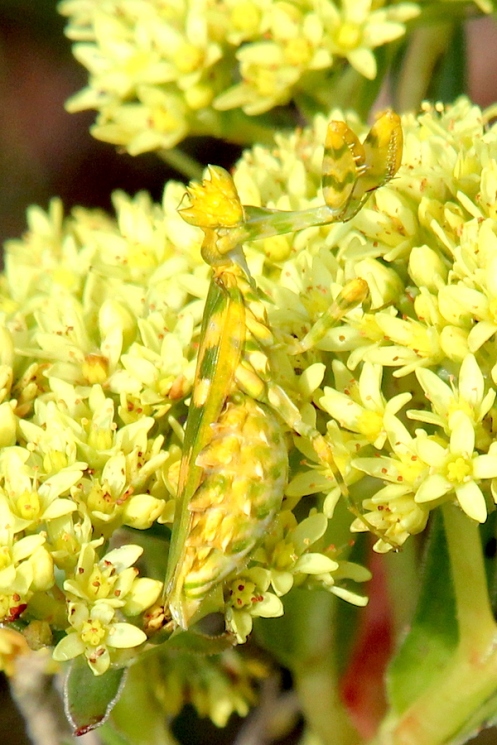
a stunning Flower Mantid, Harpagomantis tricolor;

a vibrant Grasshopper;
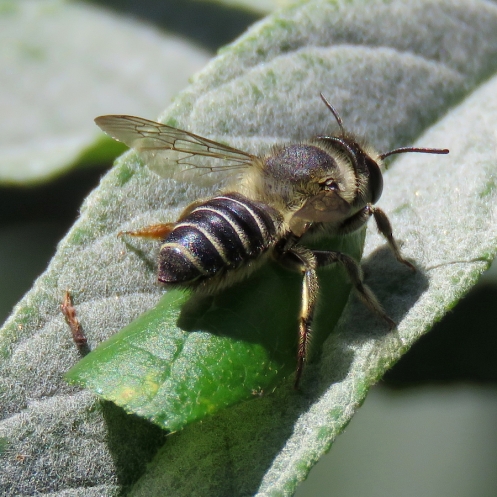
a Leafcutter Bee, Family Megachilidae;
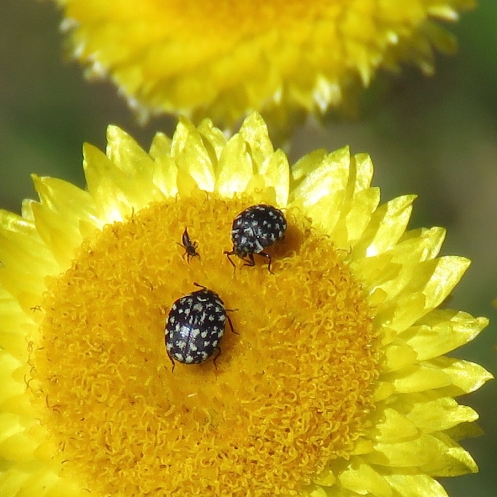
some tiny Museum Beetles, Anthrenus verbasci with an even smaller thrips;
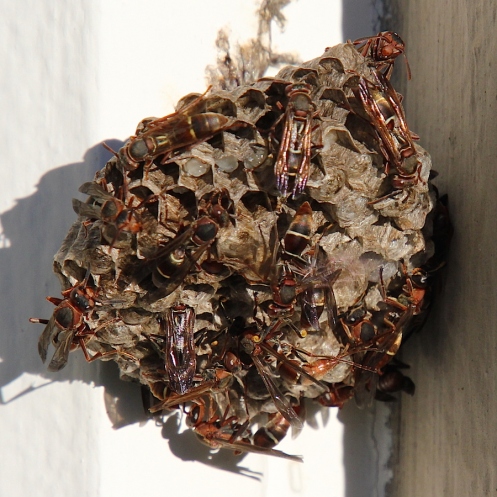
a new colony of Paper wasps, Polistes fastiotus

and a Stick grasshopper, Acrida sp..
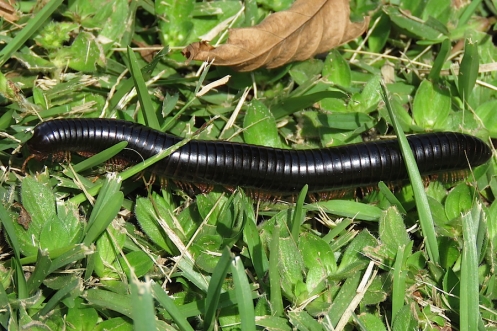
I always enjoy watching Millepedes!
In protected places I spotted some lovely spiders;

a False house button spider, Theridiidae theridion;
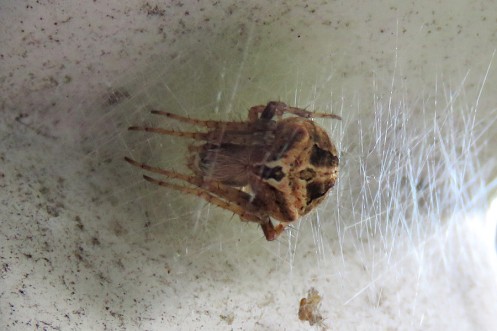
a delightful Hairy Field Spider, Araneidae Neoscona sp. of blondeli, its abdomen looked like a miniature tapestry,

and the discarded exoskeleton of a Pisauridae Family, Nursery web spider.
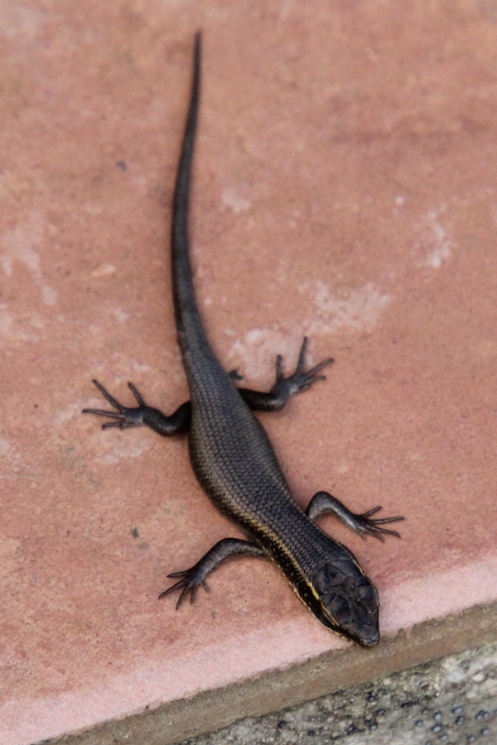
This juvenile Striped skink caught my eye, sunning on the edge of a step.
On the last day of March I had a wonderful fleeting glimpse of a male Cryptomys mahali Mole-rat as it scurried, unusually, over the ground. In 2005 Prof. Nigel Bennet came and spent a few days here looking for Cape Mole-rats, Georychus capensis, as we had found a dead one and he thought it might be part of a remnant population. They eluded him, but he did find

Cryptomys mahali male (2005),

and Cryptomys mahali female (2005).

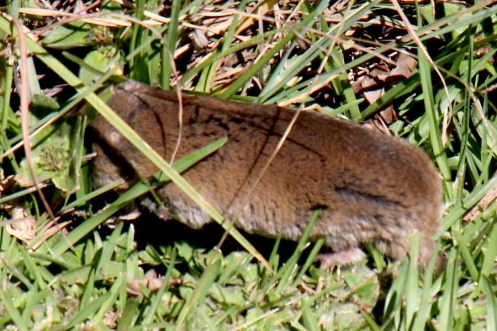
Cryptomys mahali male. This is the first time I have seen one since then, so although the photos aren’t perfect it’s a special record!
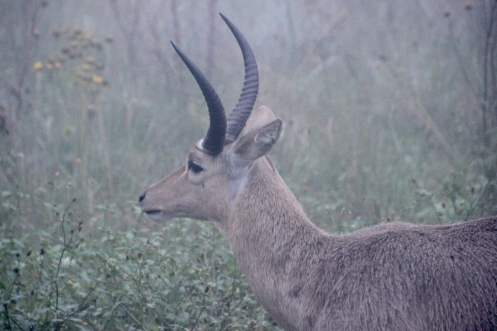
One misty evening the male Common Reedbuck paid a visit close to the house.
Several used, and now abandoned bird nests have become visible,
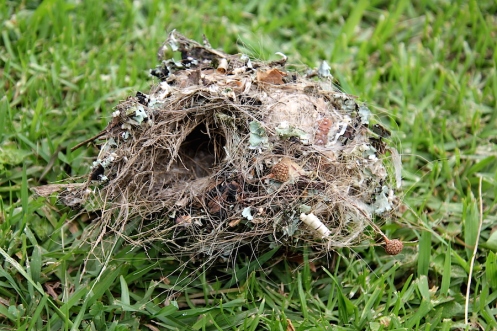
beneath a Plane tree I found a Malachite Sunbird nest, the interior beautifully lined with soft cobwebs.

Then there was a nest about 2 meters up in a tree which is unraveling when the wind blows.
There are still quite a variety of flowers out,
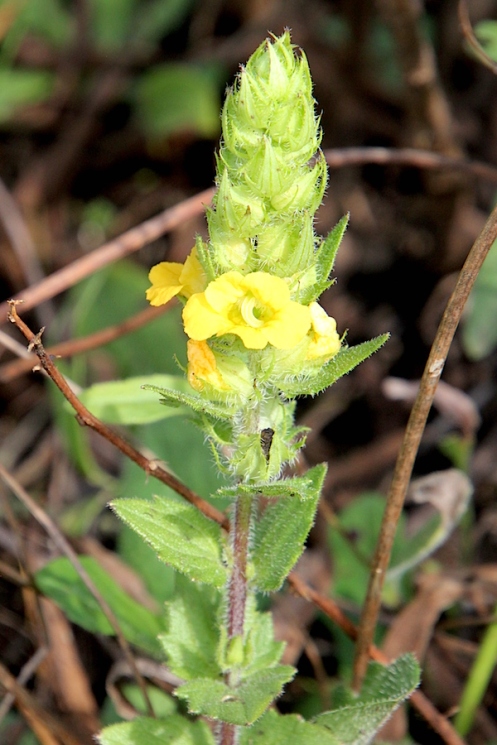
Alectra sessiliflora;
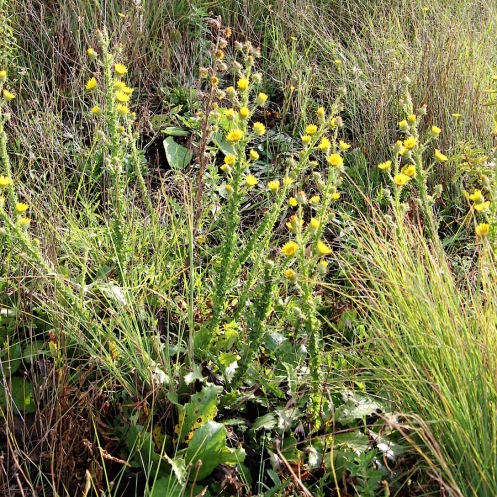
Berkeya rhapontica;
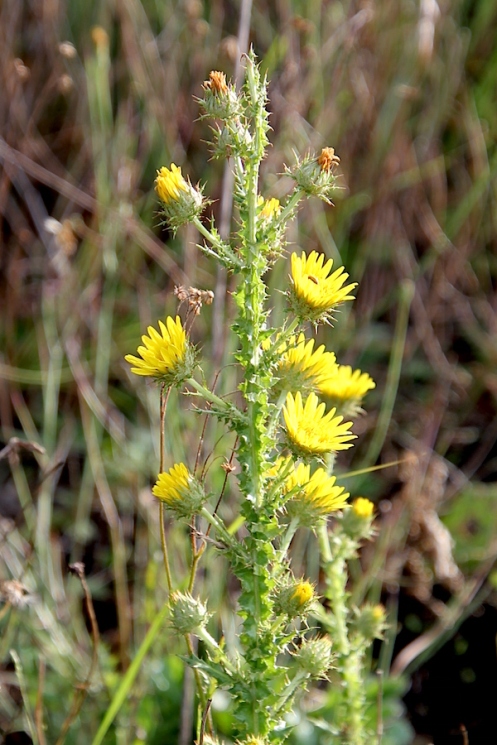
Berkeya rhapontica;
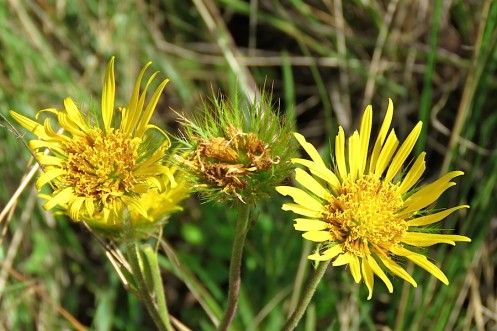
Berkeya setifera;
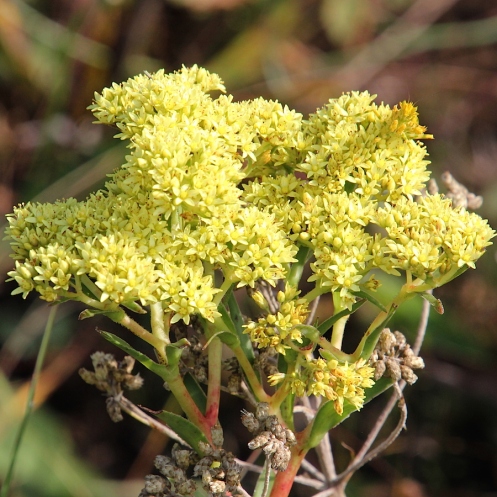
Crassula vignata, can you see the Flower mantid at the top right?

this fruiting Dwarf Spikethorn, Gymnosporia uniflora looked festive;

Dwarf Spikethorn, Gymnosporia uniflora;
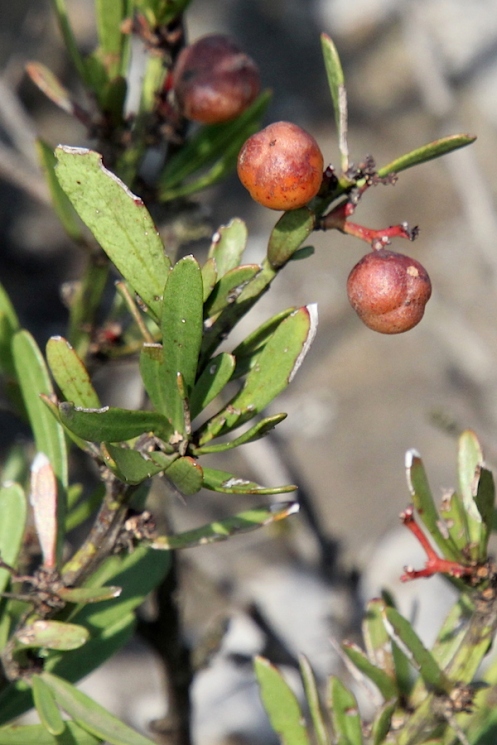
Dwarf Spikethorn, Gymnosporia uniflora;
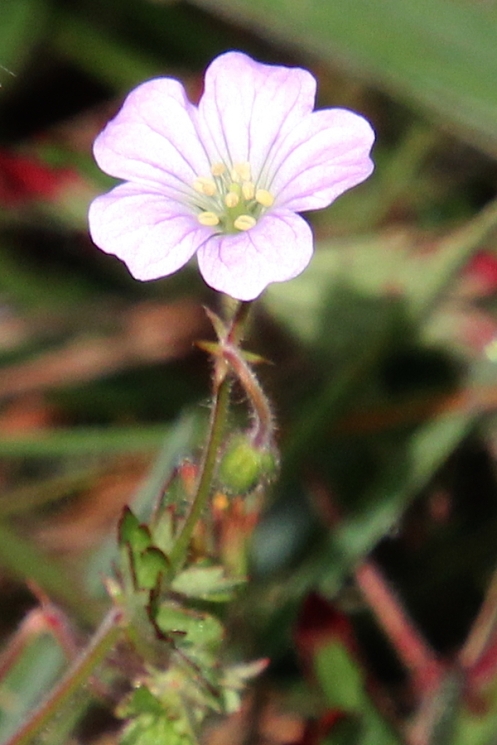
Geranium schlechteri;
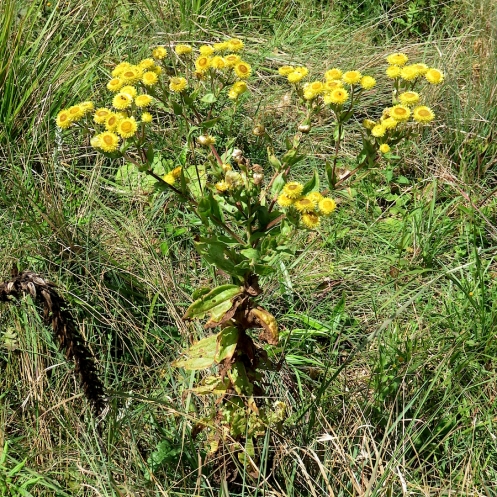
Helichrysum cooperi;

Helichrysum cooperi;

Helichrysum umbraculigerum;

Helichrysum umbraculigerum;

Hesperantha baurii;
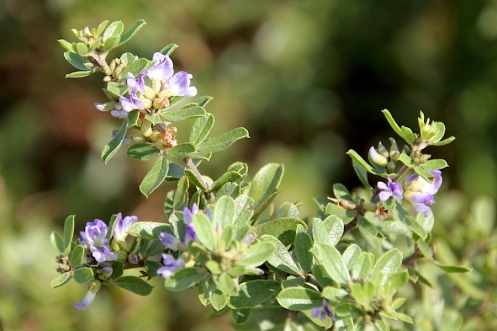
Otholobium polysictum;
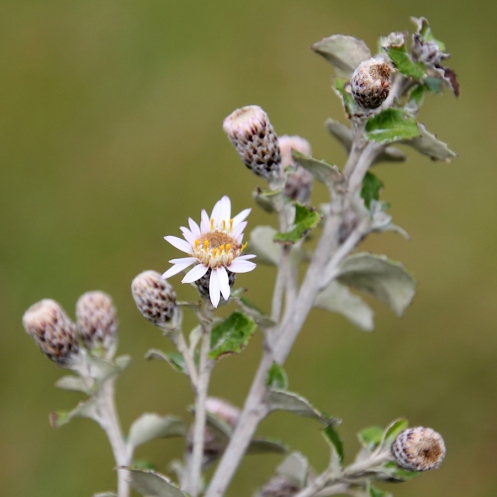
Printzia pyrifolia;
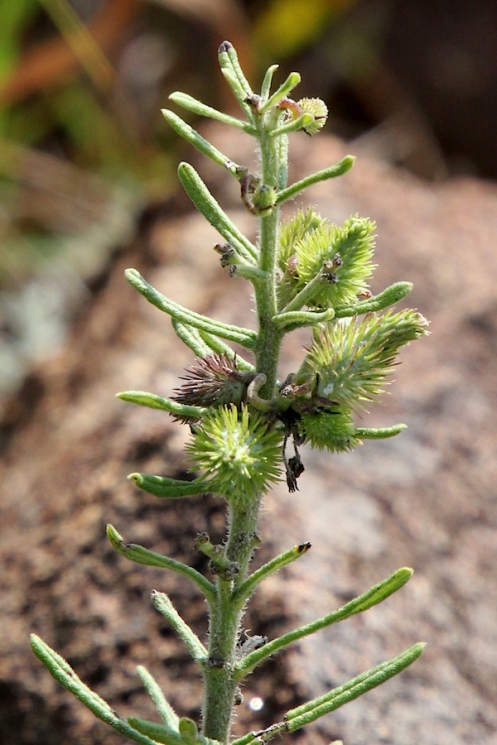
Schizoglossum bidens subsp. bidens seedheads;

the last of the Silver Bramble, Rubus ludwigii berries;
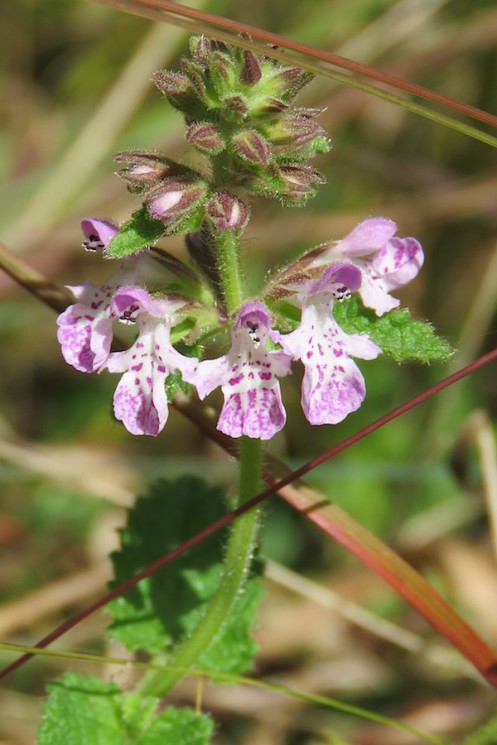
Stachys aethiopica;
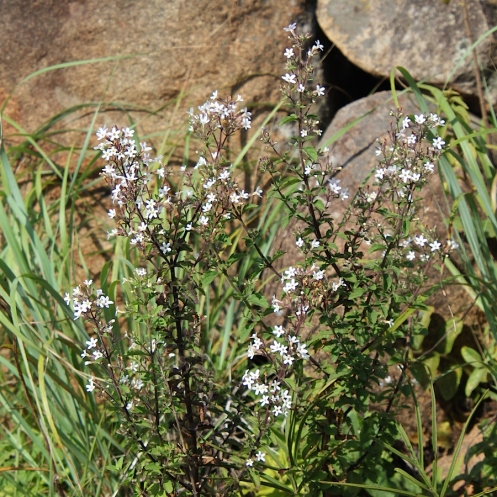
Sutera floribunda;

Sutera floribunda
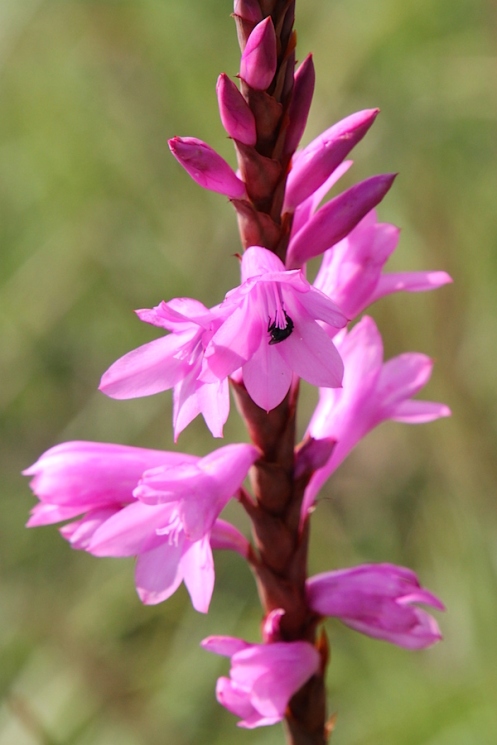
and Watsonia confusa.
Tall clumps of
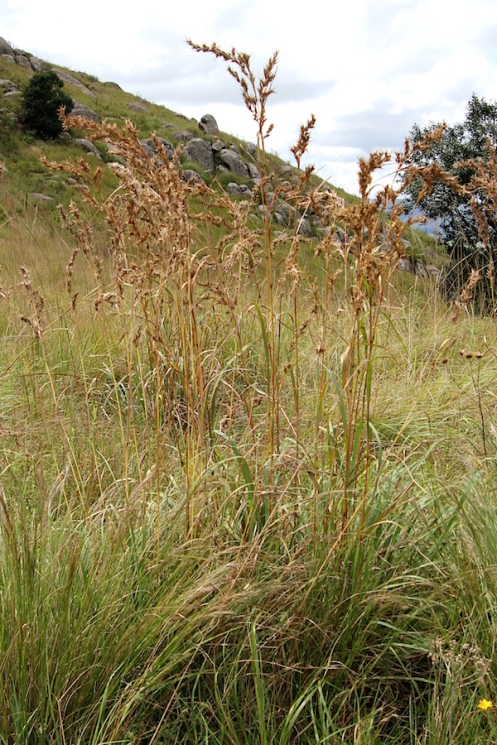
Giant Turpentine Grass, Cymbopogon validus;
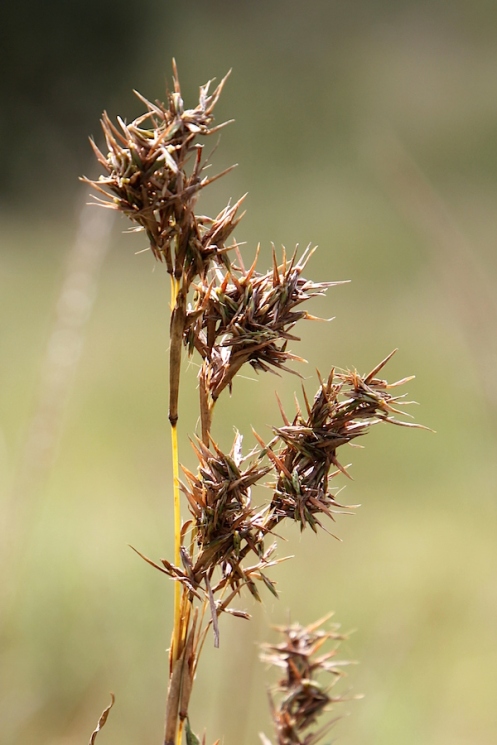
Giant Turpentine Grass, Cymbopogon validus stand sentinel on the hillside.
A fern I haven’t seen before popped up in a shady corner.
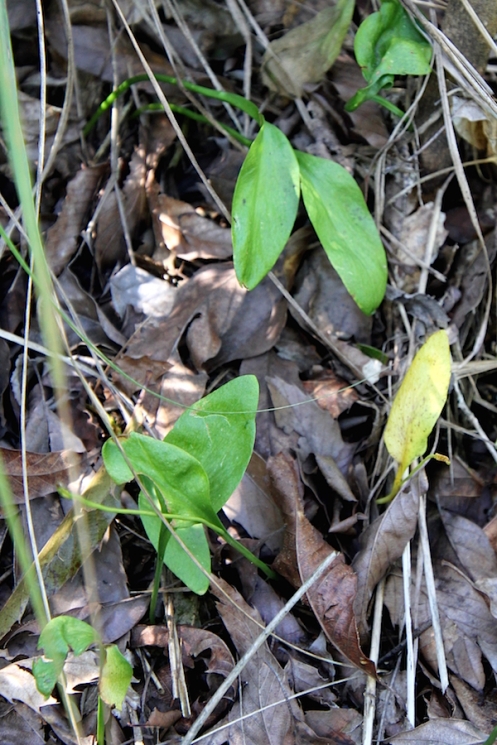
Ophioglossum vulgatum subsp. africanum;

Ophioglossum vulgatum subsp. africanum fertile spike;
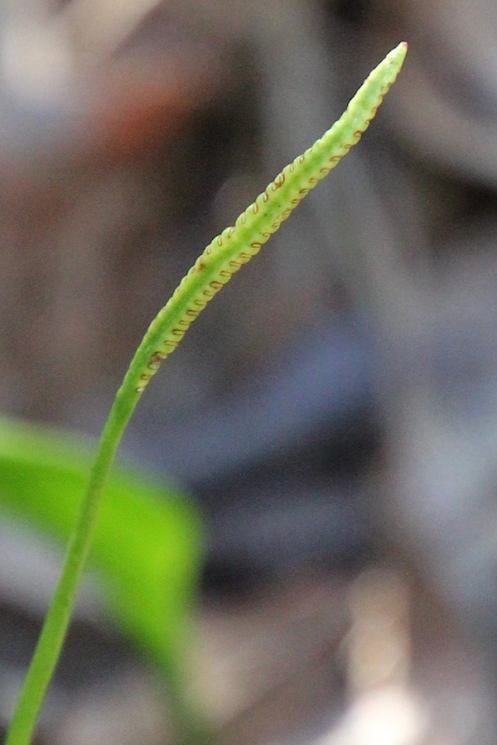
Ophioglossum vulgatum subsp. africanum fertile spike;
it is a Pteridophyte or true fern, part of the Family Ophioglossacae, Adder’s tongues.
“Fossil evidence of Ophioglossacae has been traced to the Palaeocene (±64.5-55.8 million years ago). It is a primitive and isolated family and is not closely related to any other fern group. Recent molecular studies showed that Ophioglossacae is a primitive subclass of the true ferns.”
Ferns of Southern Africa A Comprehensive Guide: N R Crouch, R R Klopper, J E Burrows, S M Burrows
pub. Struik 2011 ISBN 978-1-77007-910-6
As often happens when we have damp conditions a number of fungi appear;
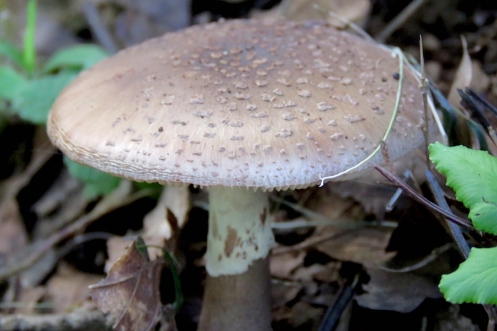
Amanita rubescens;

False Earthstar, Astraeus sp.
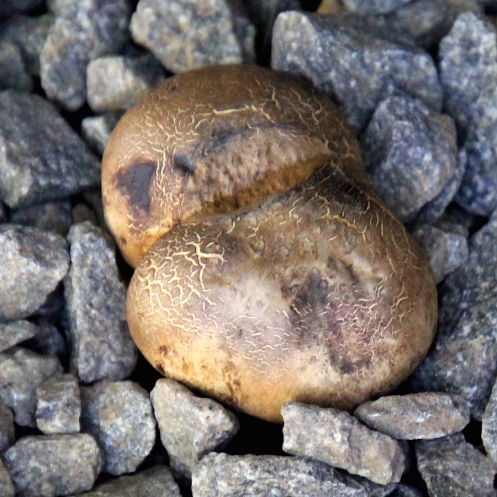
and a potato like fungi, Scleroderma sp..
We’ve had three seasons in one month in February. Some hot days, the highest temperature being 30.5C and the coolest 11C. Although there were several hot dry days we had 51.5mm of rain on the 15th, the total for the month was 236.5mm of rain, very welcome.
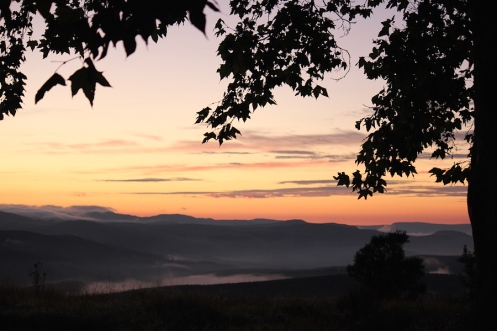
Due to the variety of weather conditions there have been some stunning early, haze mornings,
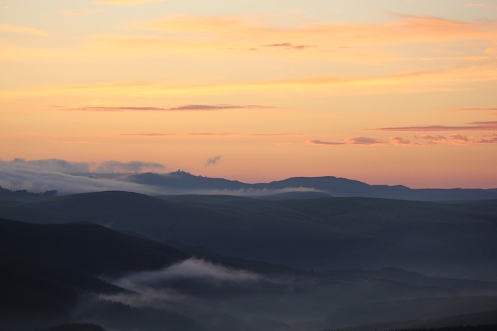
mist lapping the hillsides
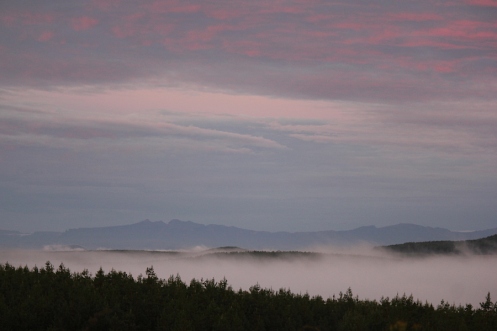
echoing dawn colour reflection over the Drakensberg,
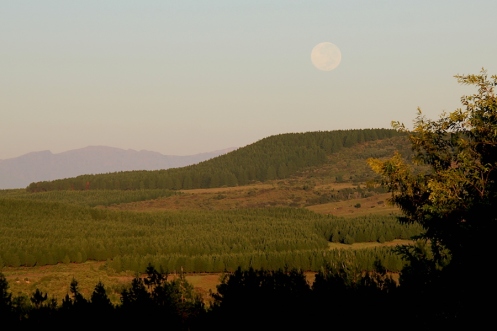
including the full moon setting on the 20th.

Some mornings the browning grasses sparkled with dewdrops,
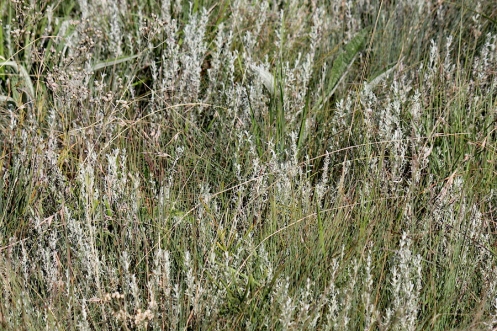
but the early signs of autumn can be seen in the dulling of colour in the grasses.
Orchids and Mushrooms are the most visible species at the moment. The good late rains have benefited the Orchids that flower at this time of year.
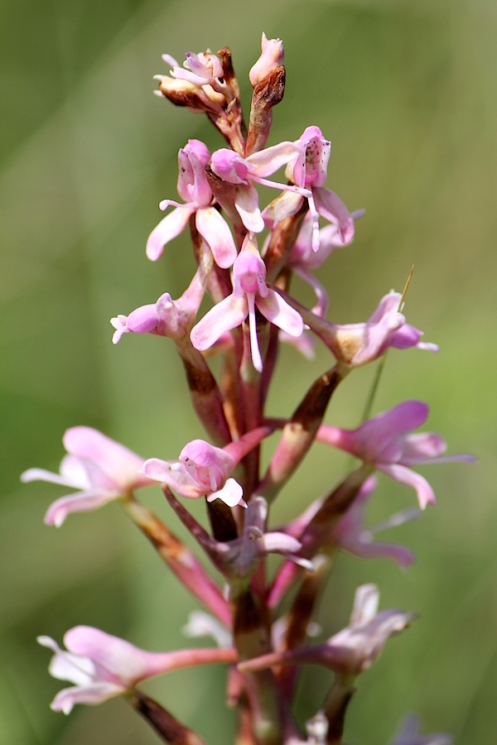

Disa patula var. patula are a Southern African endemic, I counted a population of about eight plants in various stages of flowering.

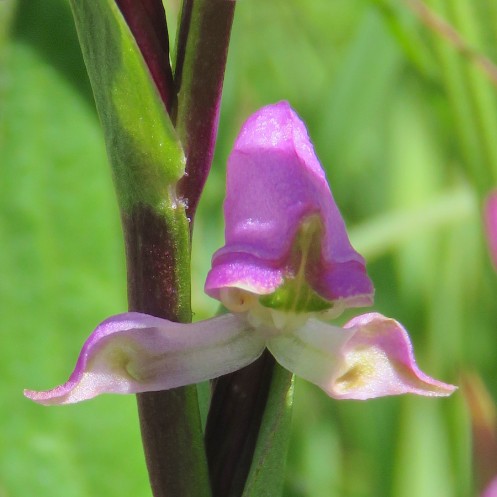
A first time sighting of two Disperis tysonii plants was so exciting!
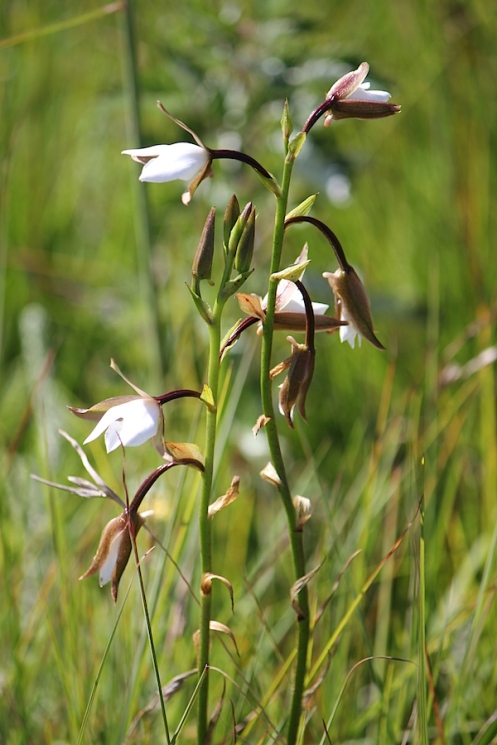
Eulophia ovalis var. ovalis;
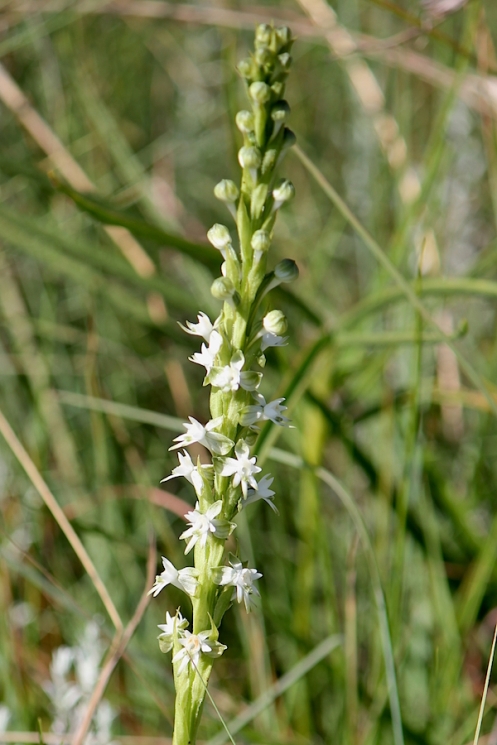
Habenaria dives and
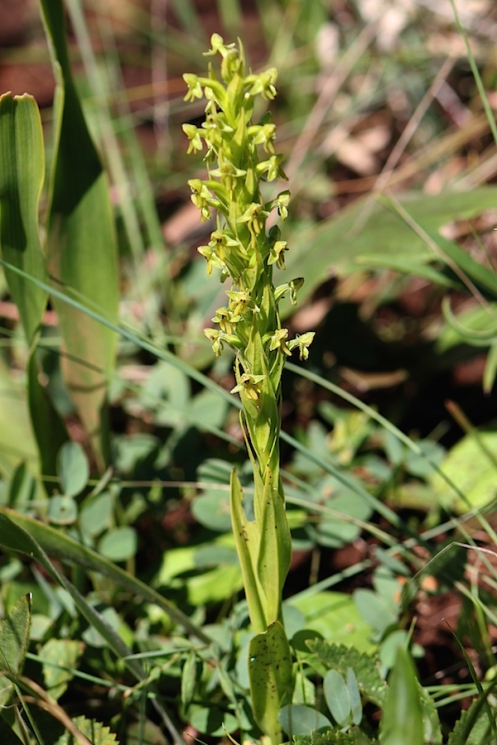

Habenaria pseudociliosa are usually seen in February;


however another wonderful first time find was also two Neobolusia tysonii plants, which I saw in late January at Garden Castle, Southern Drakensberg, also a Southern African endemic.
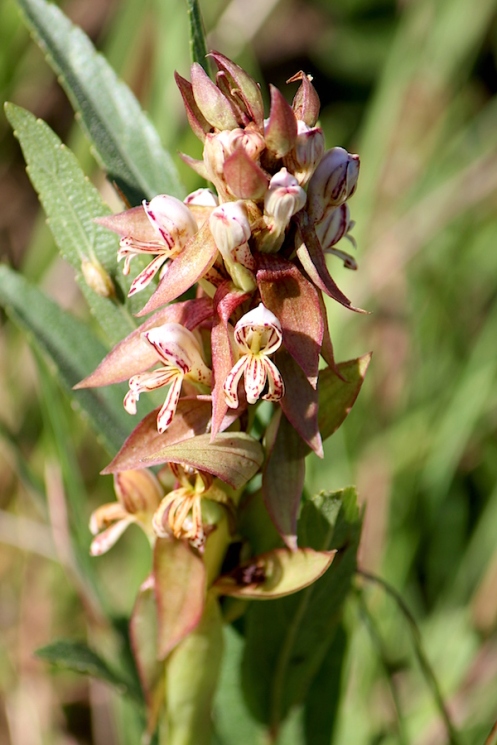
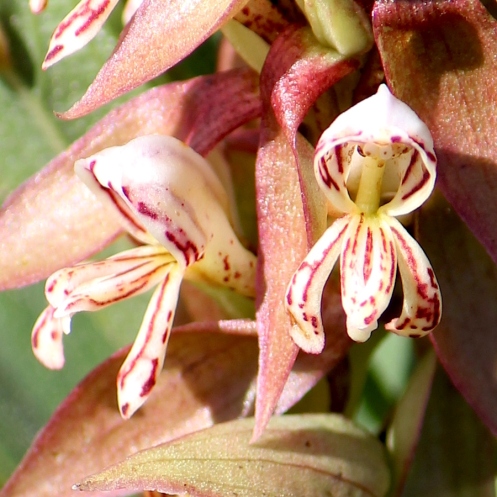
Satyrium cristatum var. longilabiatum is always a delight to see with it’s cheerful candy striping! So a total count of seven different species.
Another first sighting here was of


Crabbea hirsuta,
other flowers included:
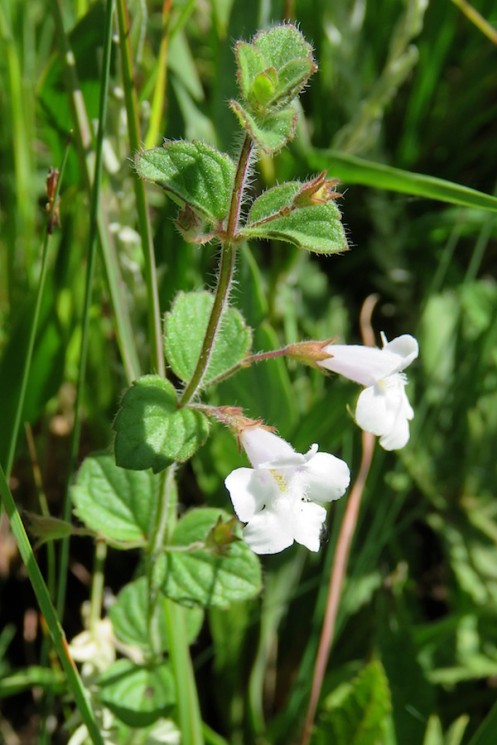
Killickia pilosa, (= Satureja reptans), which I have nicknamed Bushman sweets as their leaves have a delicious fresh mint taste;
many graceful Kniphofia wands float in the grasses,

the dainty Kniphofia buchananii
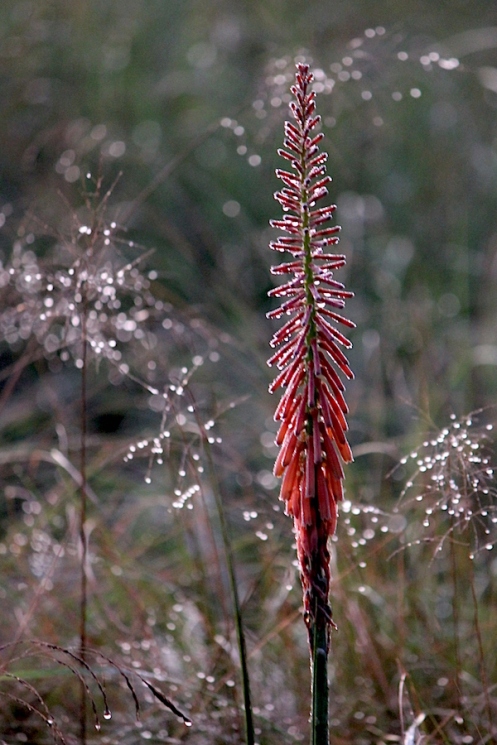
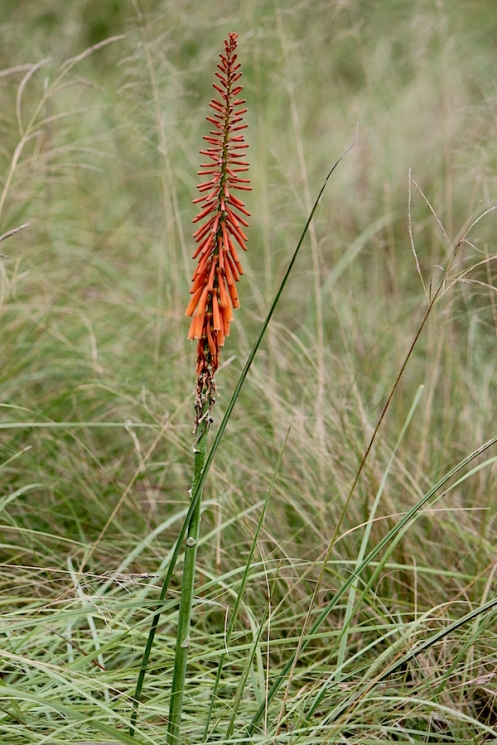
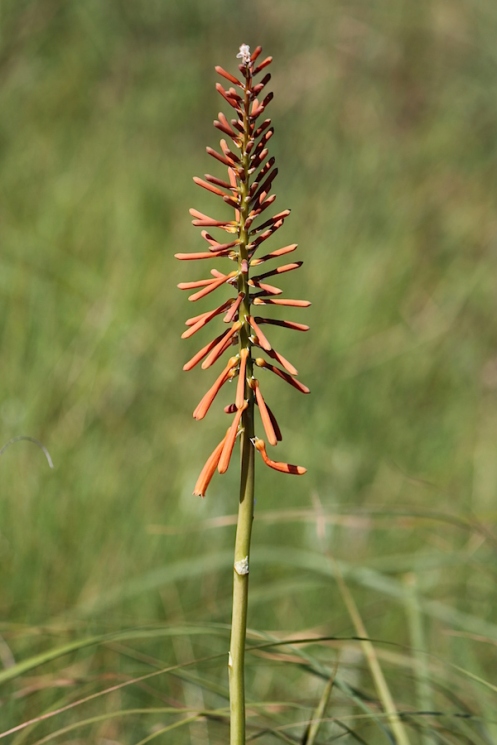
and vibrant orange Kniphofia laxiflora;
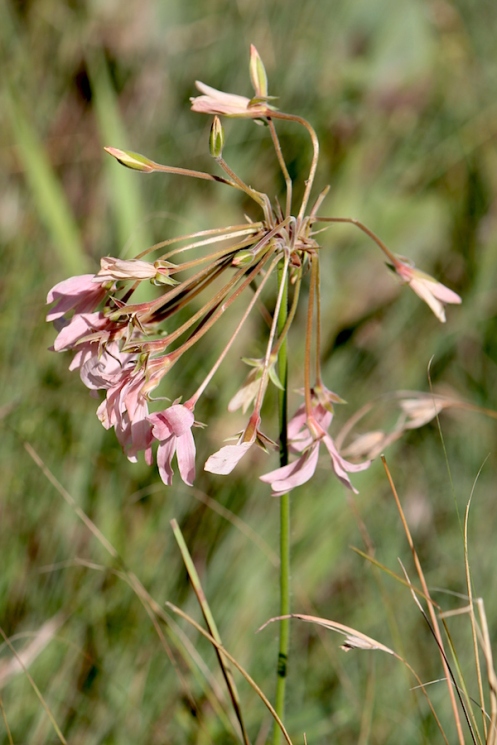
Pelargonium luridum;
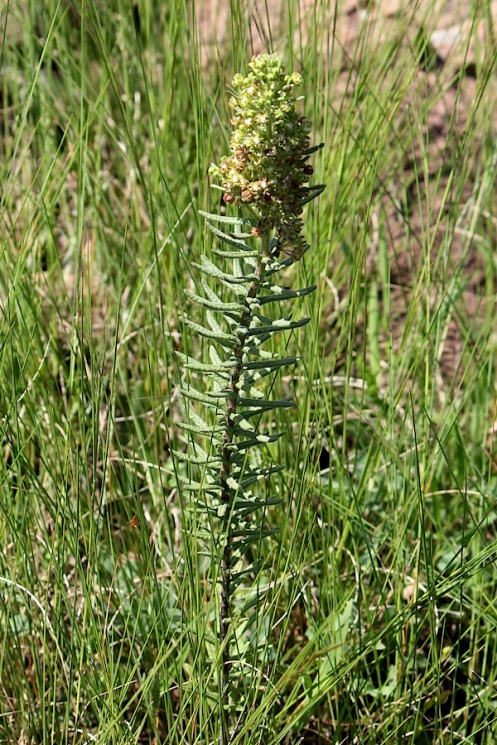
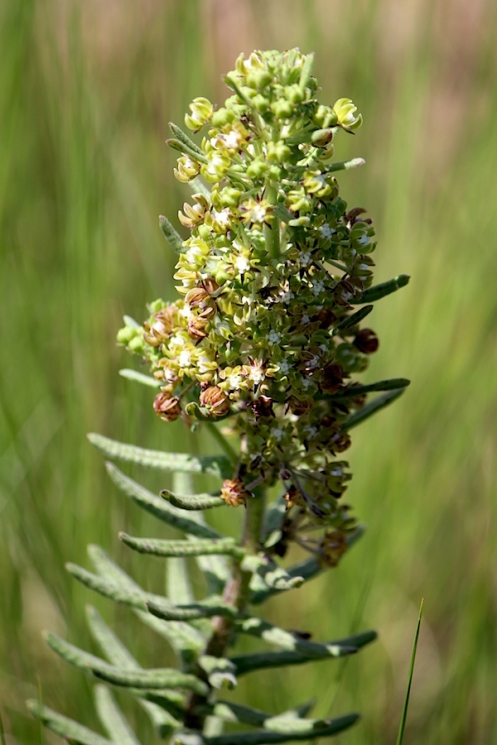
Schizoglossum bidens;
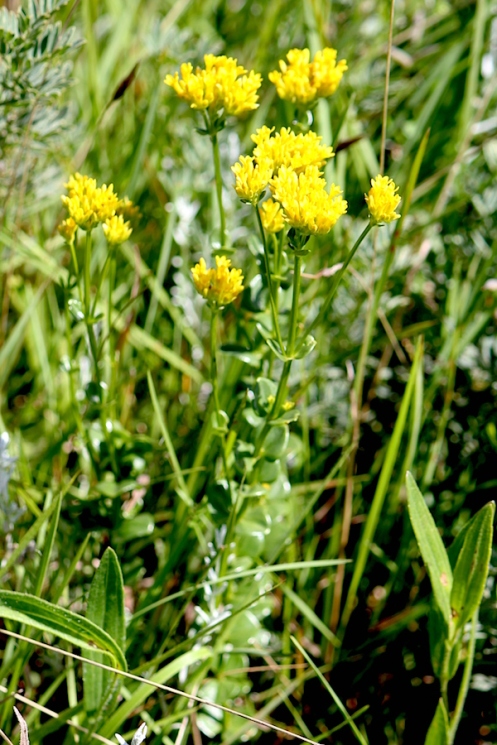
Sebaea sedoides;
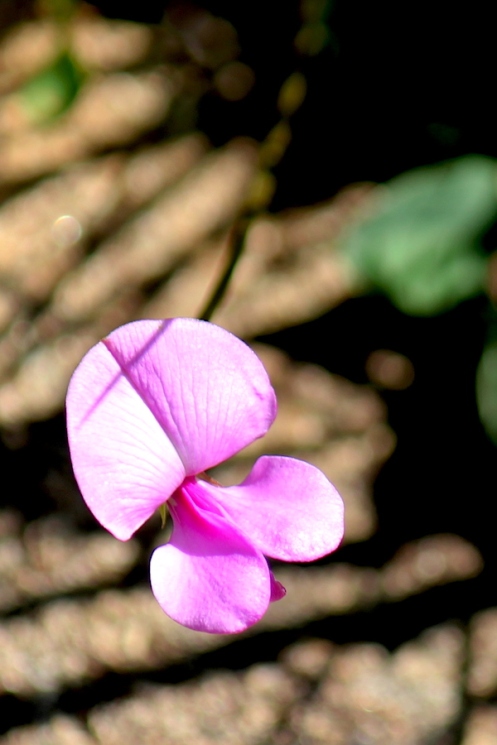
Tephrosia macropoda;
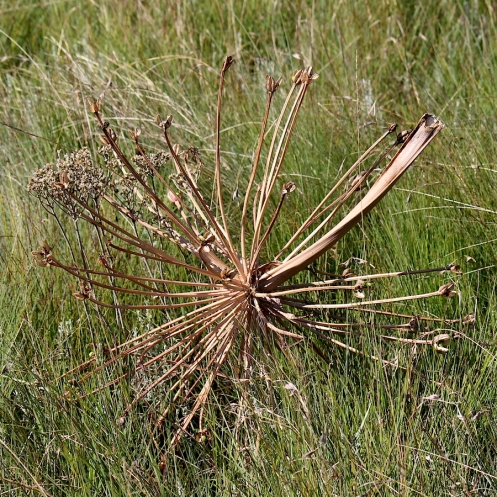
Tumbling weed, Brunsvigia undulata seedhead;
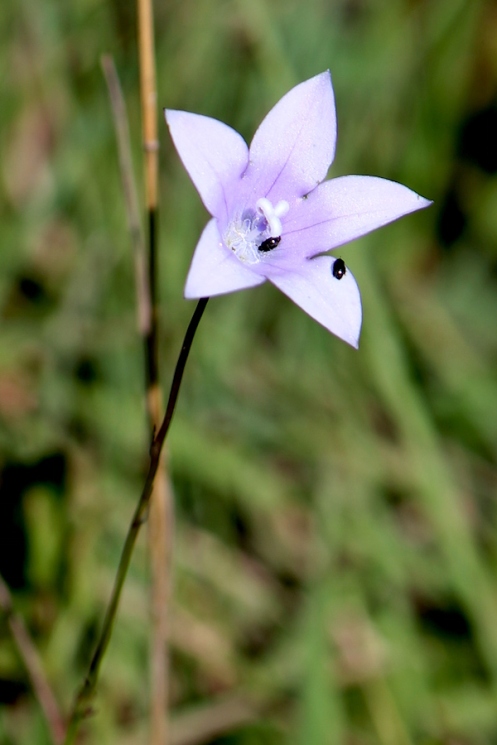
Wahlenbergia krebsii;
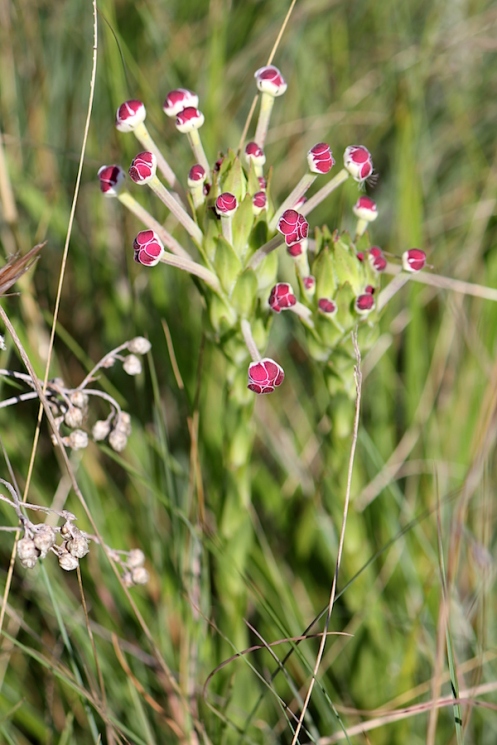
Zaluzianskya natalensis
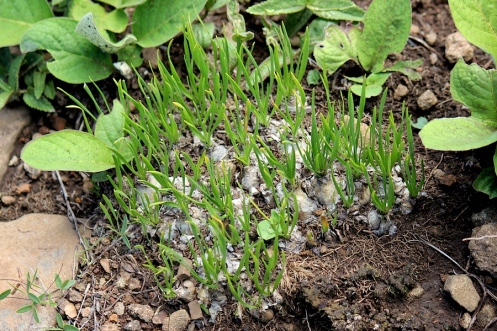
and possibly a patch of Ledebouria stenophylla which haven’t flowered this season.
Some interesting mushrooms popped up after the heavy rain,

Amanita rubescens;
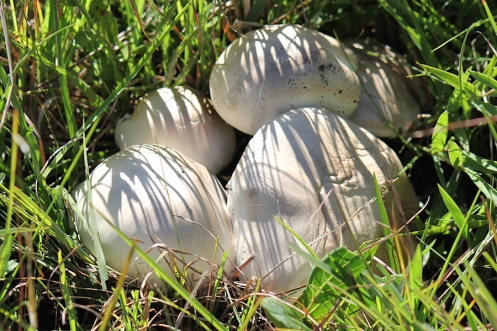
Horse Mushroom, Agaricus arvensis;

Parasol Mushroom, Macrolepiota zeheri

and possibly Campanella capensis.
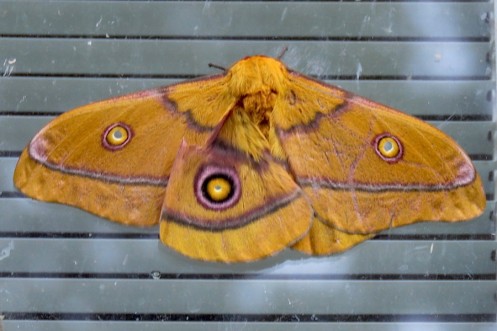
This rather battered Emperor moth sp, Family Saturniidae rested at dawn, it’s torn lower wing meant I could see the usually obscured ‘eye’.
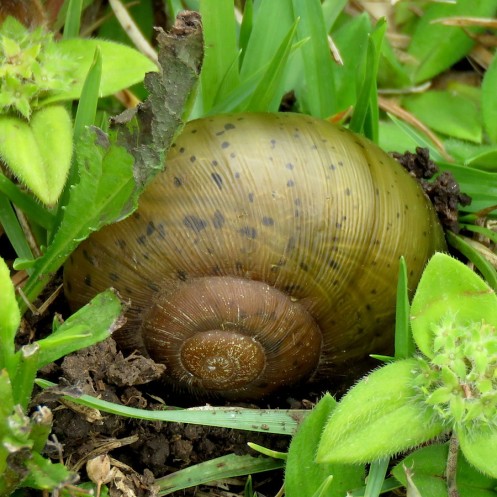
It was very special to discover a Common Cannibal snail, Natalina cafra, in the lawn. I also saw a broken empty shell in different place, clearly a bird had eaten escargot!
Birds are not as frenetic, their broods probably fledged and more self-sufficient now. An early atumn season sighting of both a Malachite Sunbird and an African Hoopoe were a delight. One morning a Spurwing Goose perched on a rock above the valley, surveying the mist haze below.
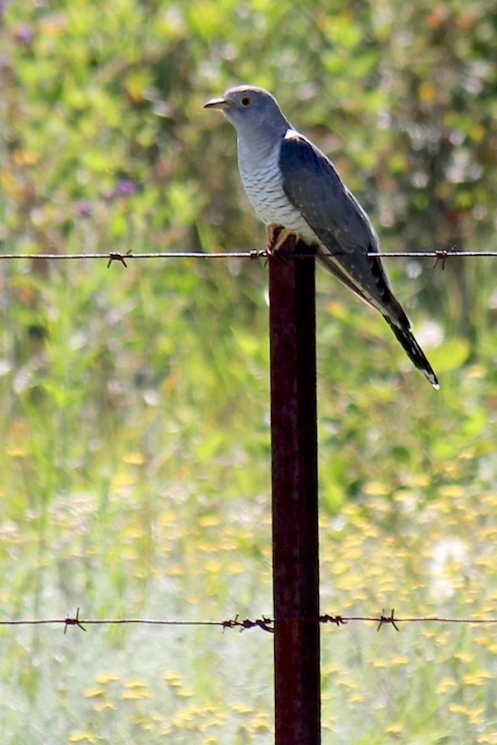
The most exciting bird seen, was what I think is an African Cuckoo! Although it is a bit south of it’s usual summer sojourn, the broader, deeper bill with yellow at it’s base, differentiates it from the Common Cuckoo; this was also a first sighting here! It is a fairly common breeding, (Brood parasite of Fork Tailed Drongos), intra-African migrant, August-April, though not usually found here in the Midlands of KwaZulu-Natal.

New Year morning sunrise was particularly beautiful, clouds enabling colour-filled skies.

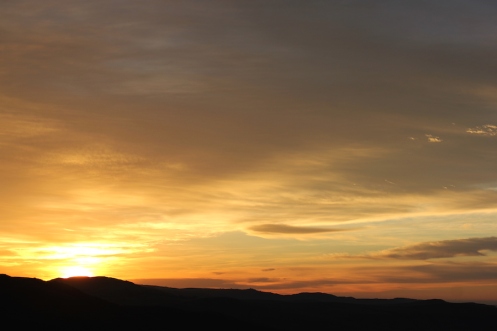
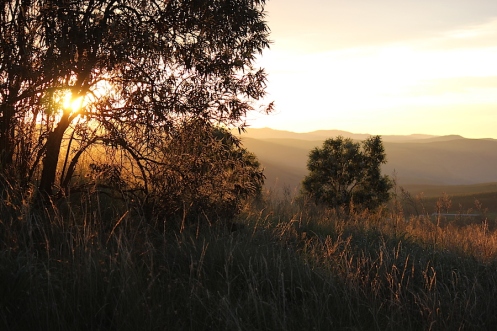
During January we had 158.5mm of rain, a bit less than December, but very welcome. A more usual pattern of afternoon thunderstorms occurred, however most didn’t realize much rain, there were also several misty, damp days. The hottest temperature was 31C and the lowest 10C
January has been a moth month:
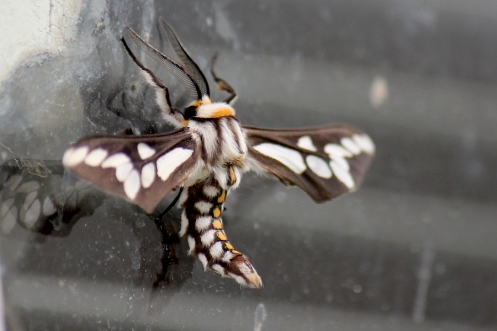
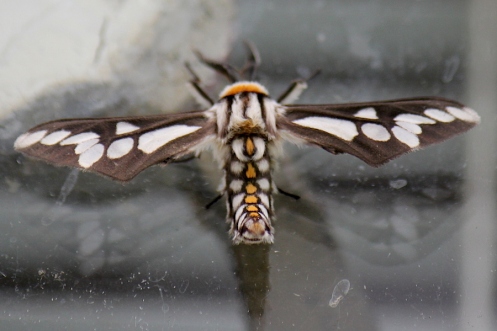
a very distinctive African Hand Maiden moth sp. of the Family Thyretidae;
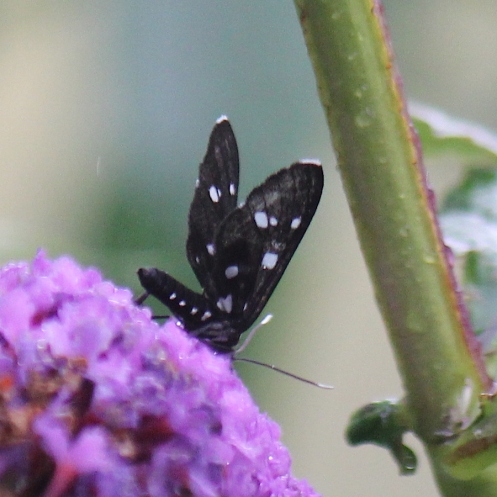
a Handmaiden moth sp. of the Family Ctenuchidae;
several of the Emperor moths were seen in the early mornings,
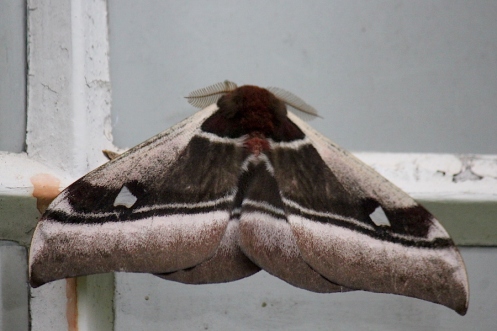
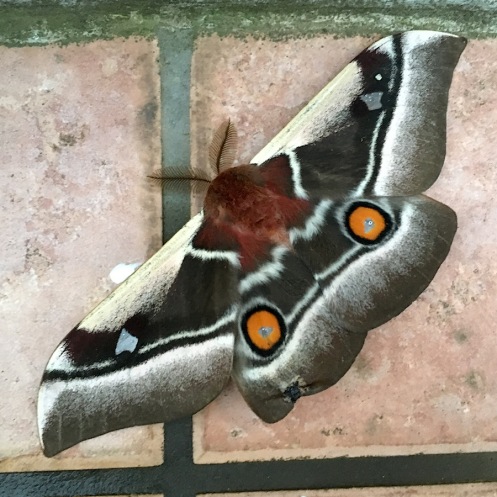
Common or Cabbage Tree Emperor moth;
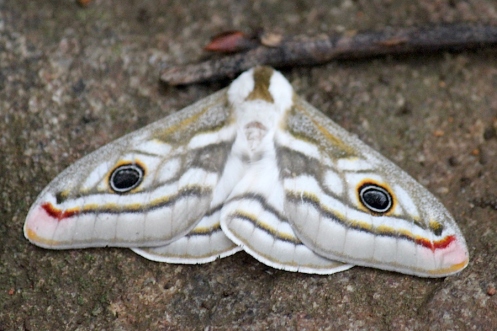
Marbled Emperor moth;
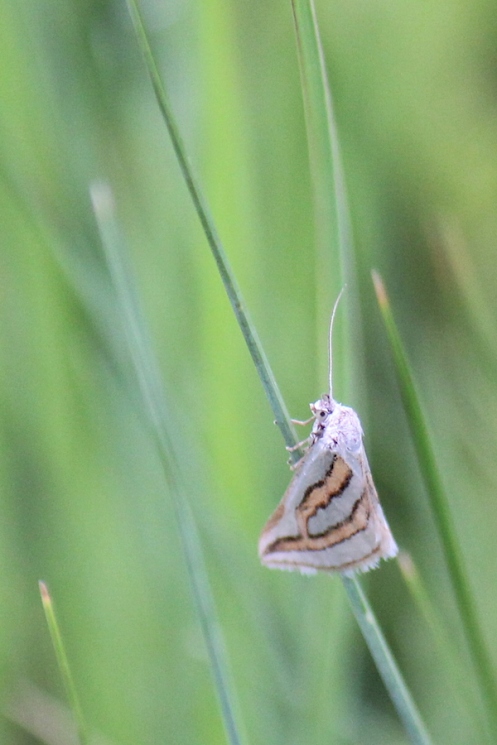
a delightful, very small banded moth;
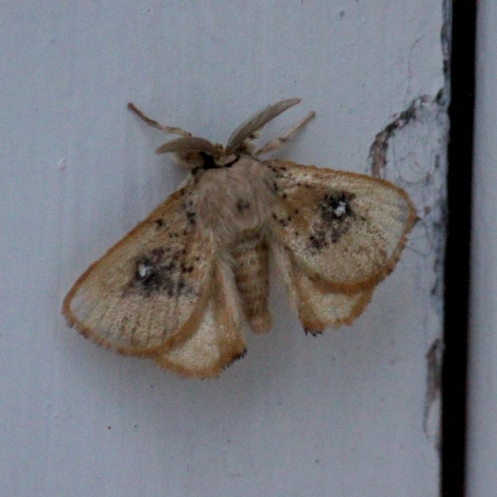
possibly a Monkey moth sp. of the Family Eupterotidae and
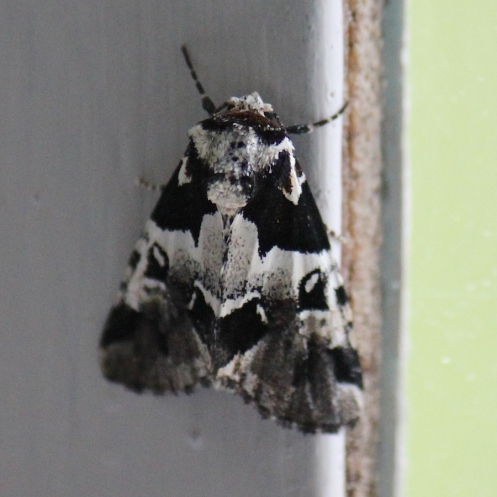
a gorgeously black and white marked moth.
There have been many stunning butterflies fluttering by, most not close enough or still long enough to photograph, however I did manage to capture an image of these two beauties:
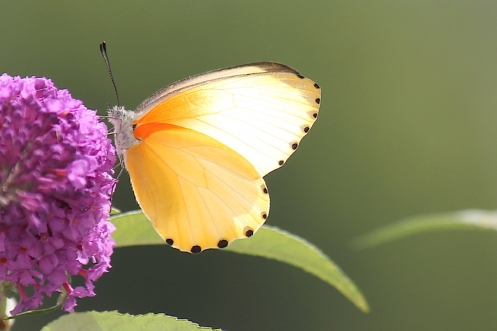
Common Dotted Border, Mylothris agathina agathina and
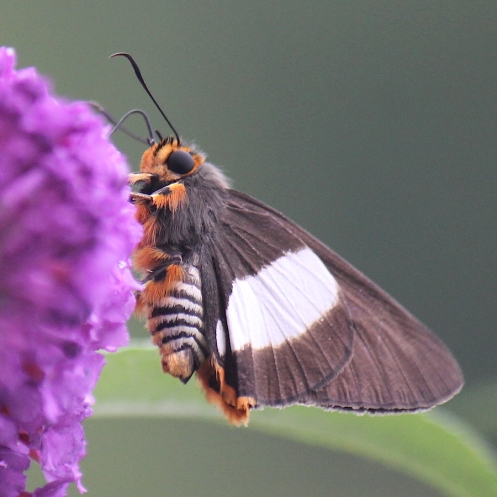

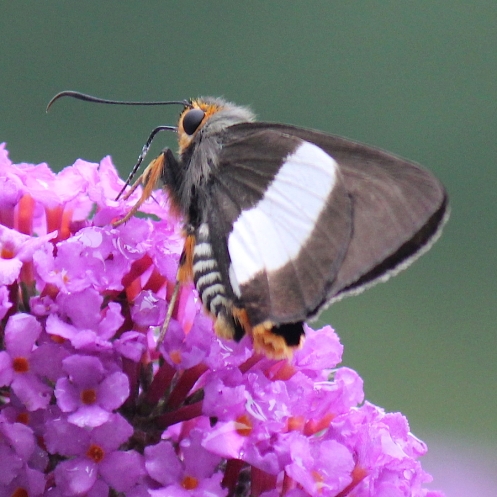
Striped Policeman, Coeliades forestan.
Red-winged Starlings have been trying many different places to build a nest, for a while on top of the light fitting outside the kitchen door, it fortunately didn’t ‘stick’! Hadeda Ibis wander the lawn spearing tasty morsels.
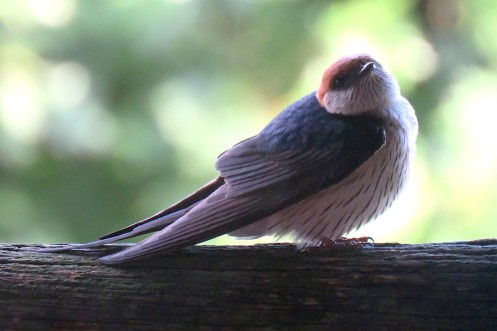
A delight was managing to photograph a Greater Striped Swallow on the verandah railing one misty morning.
The single

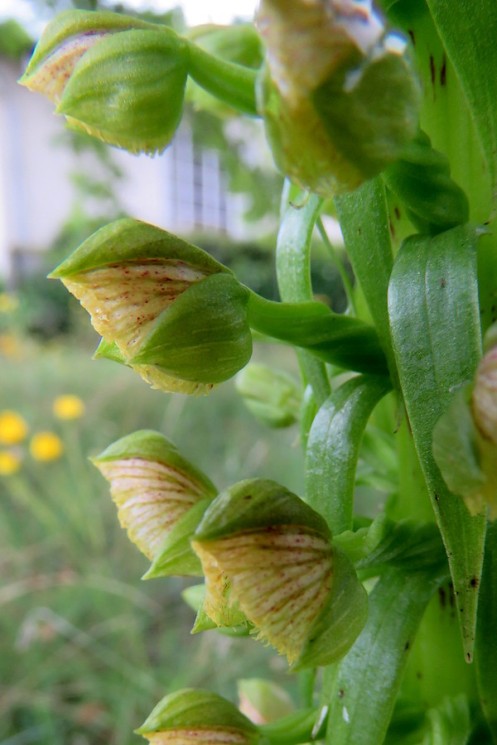
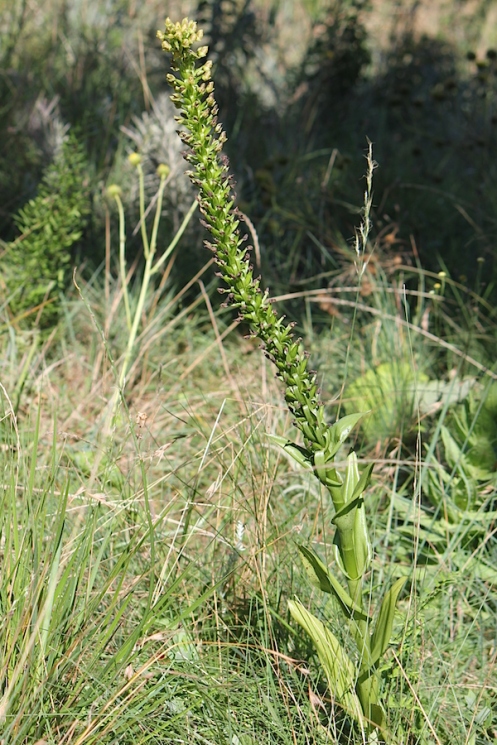

Pterygodium magnum inflorescence continued growing, finally reaching ±1m, although buffeted by storms it flowered all through January, the final flowers have just opened, two young plants have come up next to it.
I spotted a few more orchids in flower:
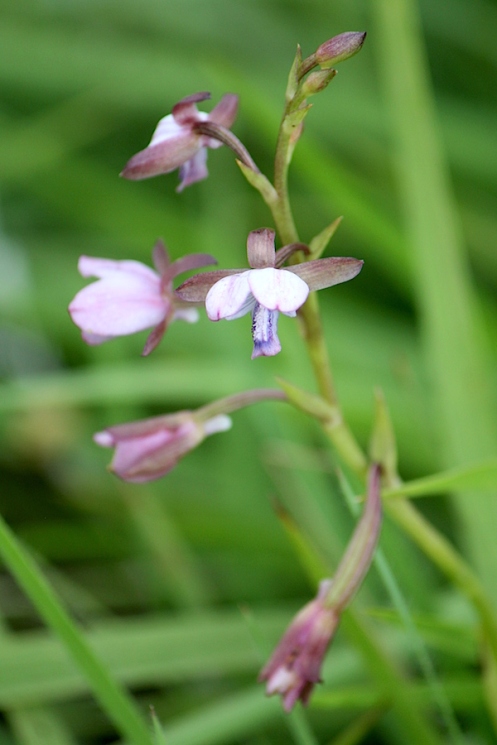
Eulophia hians var hians;
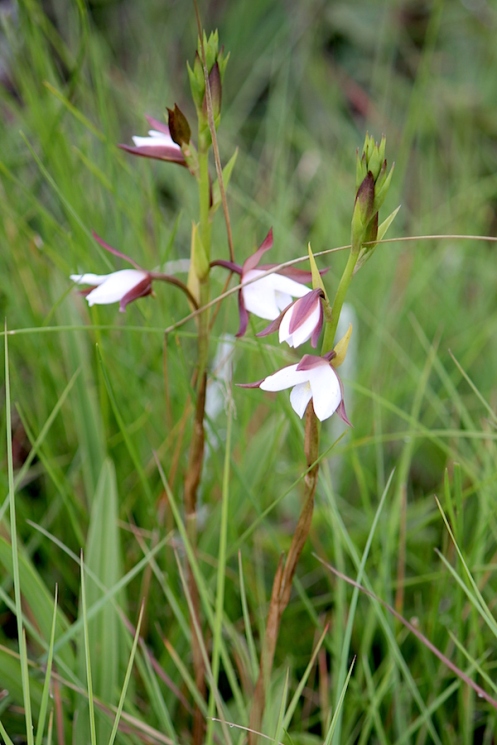
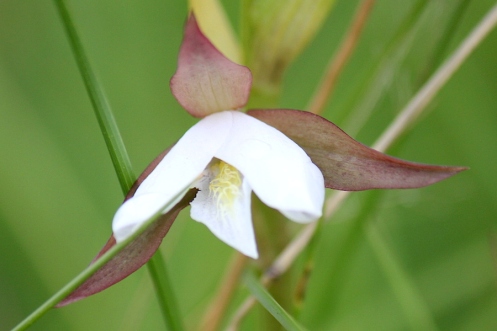
Eulophia ovalis var ovalis;

Eulophia zeyheriana;
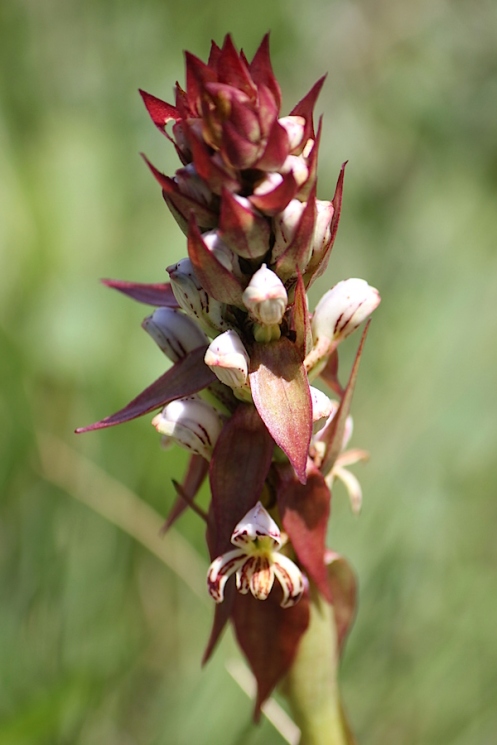
Satyrium cristatum;
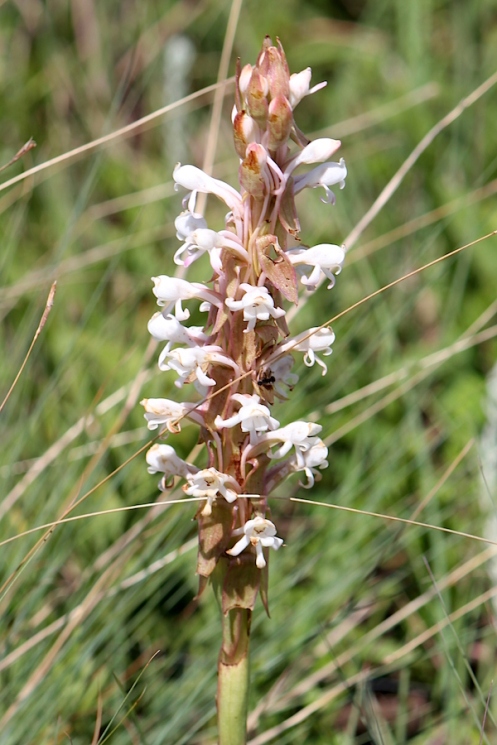
Satyrium longicauda and
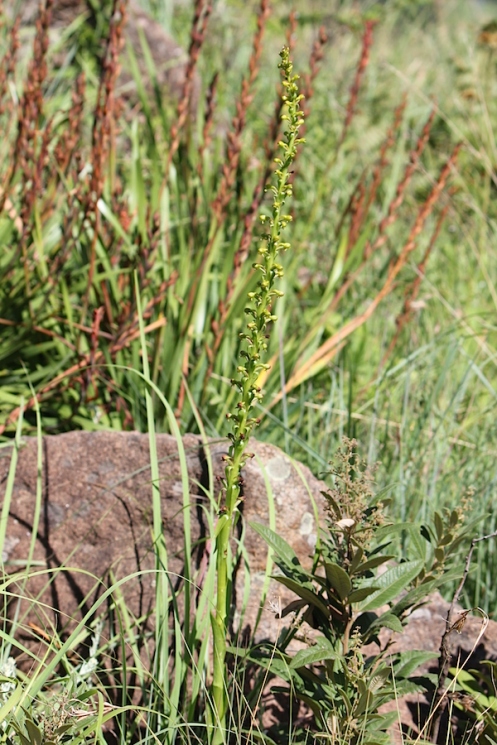
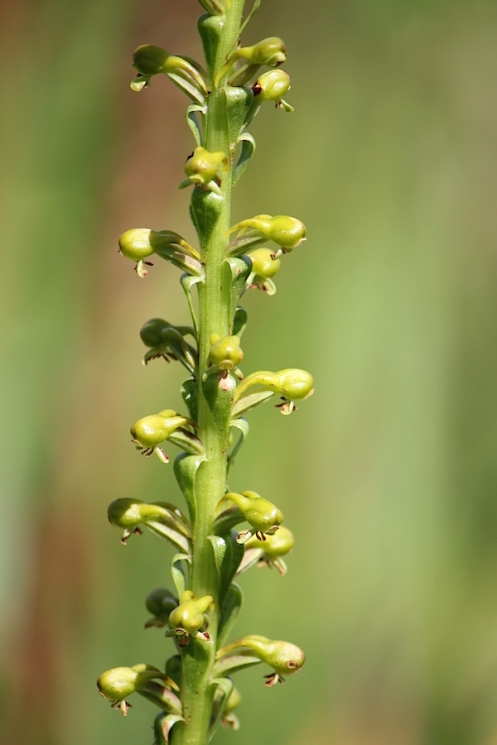
Satyrium parviflorum. Almost all of the flowering inflorescences are shorter than most years, possibly due to a lack of rain in the Spring.
Other flowers seen and photographed are:
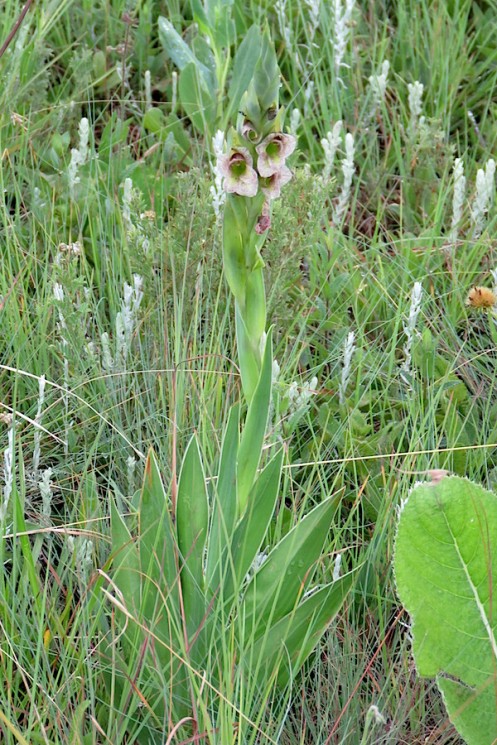
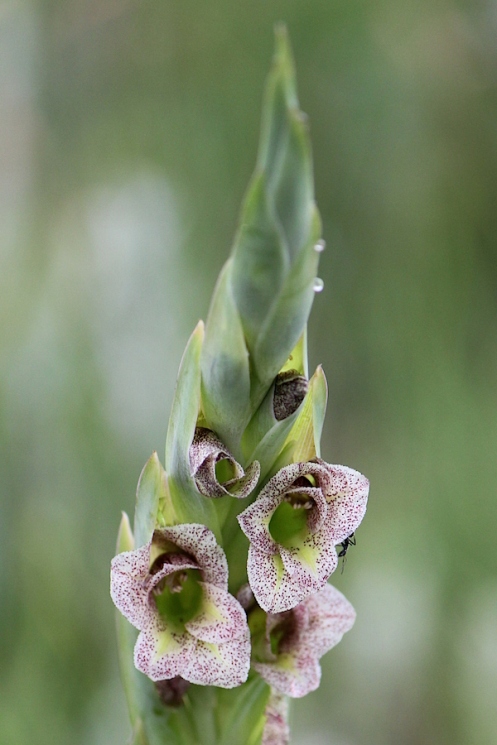
Gladiolus ecklonii;
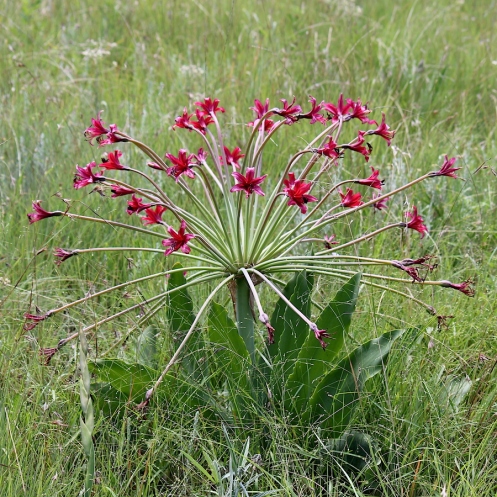

Brunsvigia undulata;

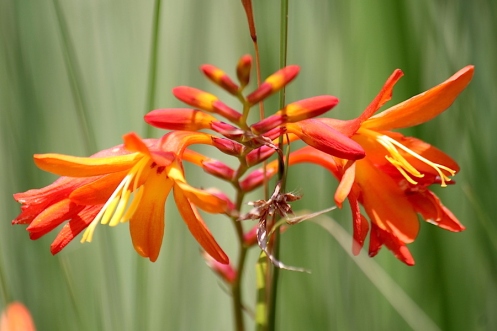
Crocosmia aurea, I have just learnt an interesting fact, one of the methods of seed distribution is by Vervet Monkeys, they find the seed very palatable and leave them behind in their droppings and

lastly Heliophila formosa.
After the last rain,
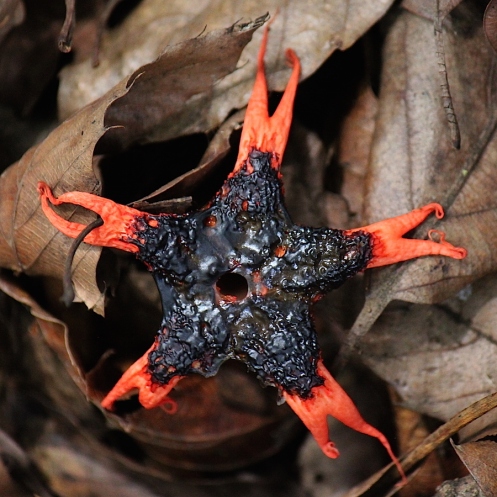
a Star Stinkhorn, Aseroe rubra, appeared in leaf litter.
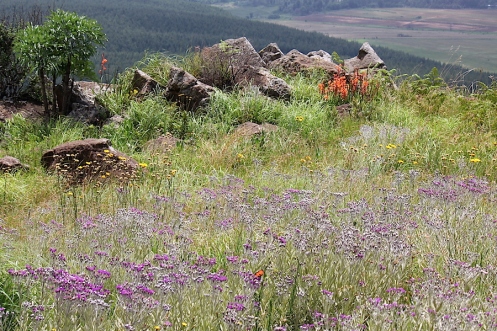
During December we had 192mm of rain, to late to make a real difference to the natural vegetation, but very welcome. It’s interesting that the ‘normal’ summer weather pattern is not in place, most of the rain and thunderstorm activity is the result of abnormal cold fronts reaching way north. Our well water has risen again yoyo fashion! The hottest temperature was 31C and the lowest 7.5C
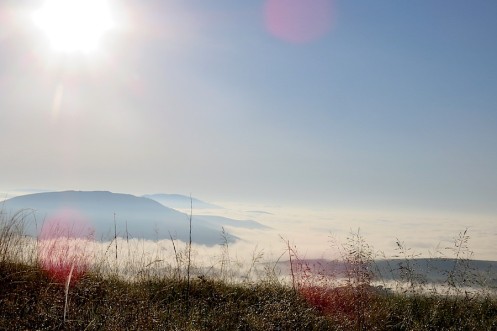
The hillsides have turned a verdant summer green, though seeding grasses gild the slopes. There have been several mornings when the valley below is filled with a sea of rising mist.
One of our joys is the resident group of Common Reedbuck that we see on a daily basis as they move around the property.
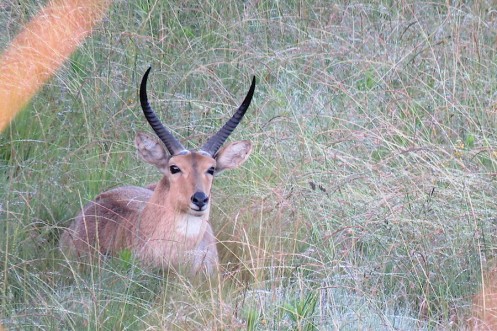
I saw this beautiful male Common Reedbuck settling down for his daytime nap just as the sun rose one morning.
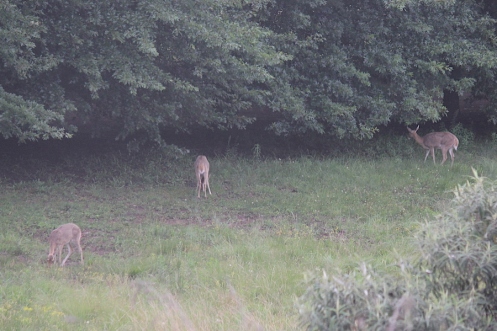
Often they graze below the orchard near the driveway.
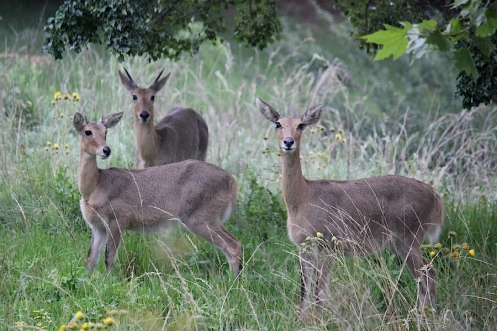
One evening three came right up near the house to graze.
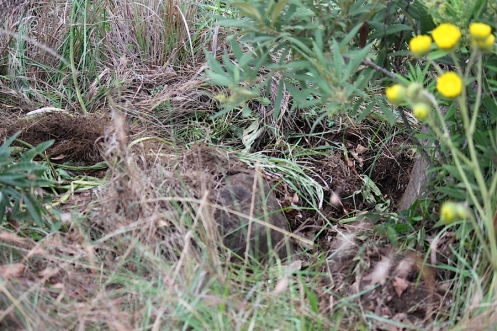
Evidence of a very large Bushpig, which we have seen a couple of times, is clear where he uprooted a beautiful clump of Grassland Arums, Zantedeschia albomaculata and cleaned up all the fallen plums under the tree near the house.
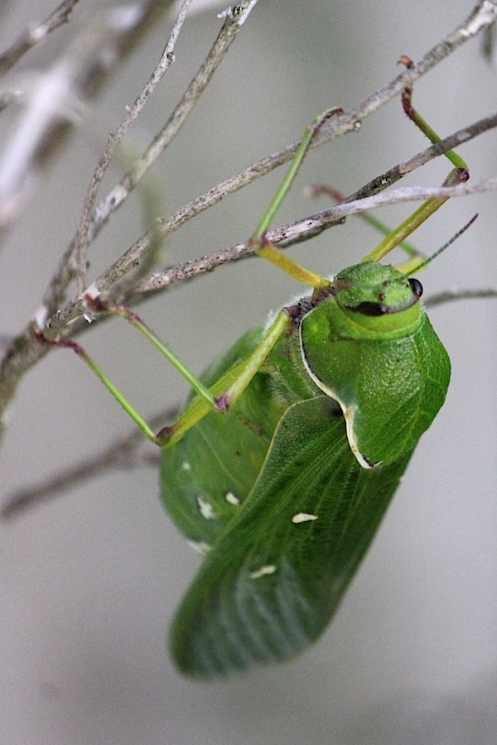
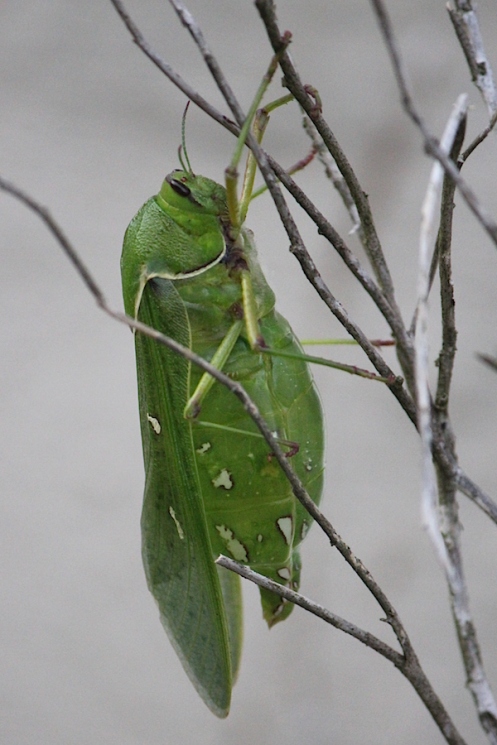
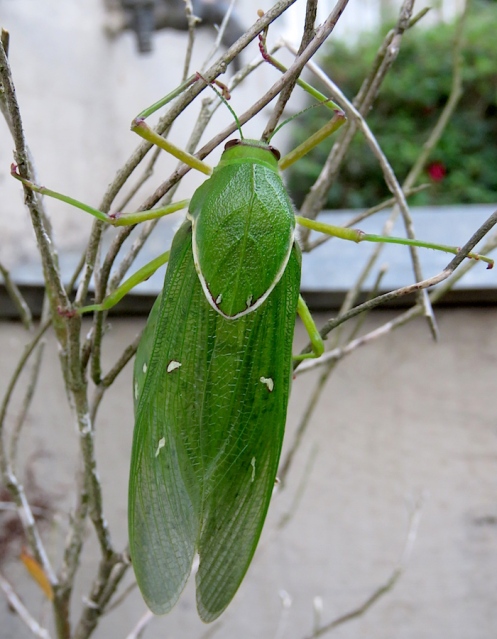
A very striking Bladder Grasshopper, Pneumora inanis, with a very loud call, perched on bare branches near the kitchen door.
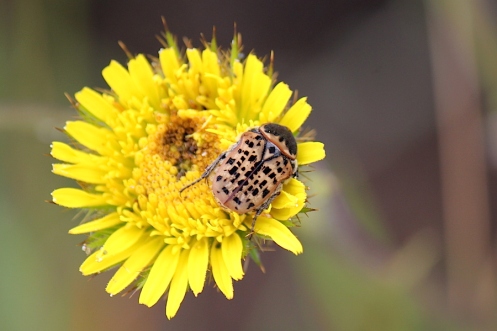
A Chafer beetle of the Family Scarabaeidae was spotted munching the florets of a Berkheya setifera flower.

The pollen of a Papaver aculeatum attracted an unusual brown fly.
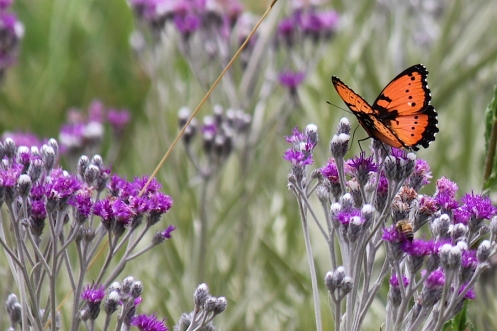
The vibrant orange of the summer form of the Gaudy Commodore, Junonia octavia, shone brilliant in a sea of purple Vernonia.

I almost missed this dainty little grasshopper, a Lentula species. They don’t have wings in their adult form.
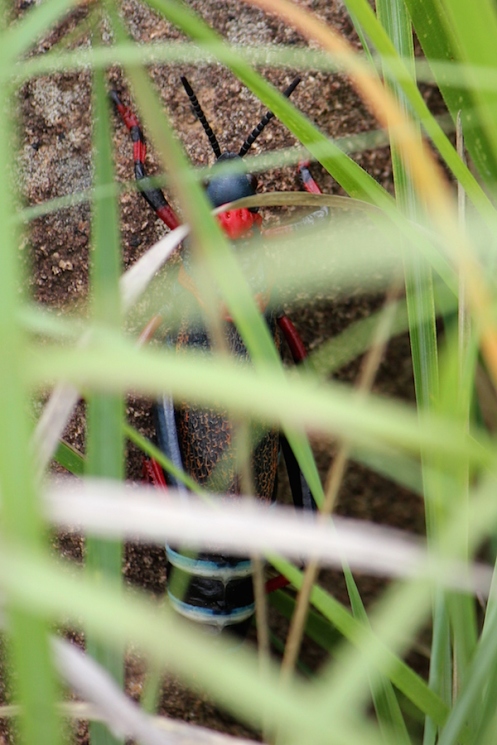
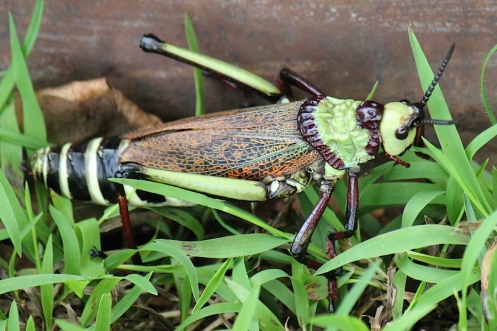
On several occasions I saw Koppie Foam Grasshoppers, Dictyophorus spumans, in two colour variations. One was deliberately hiding itself from me under the grass.
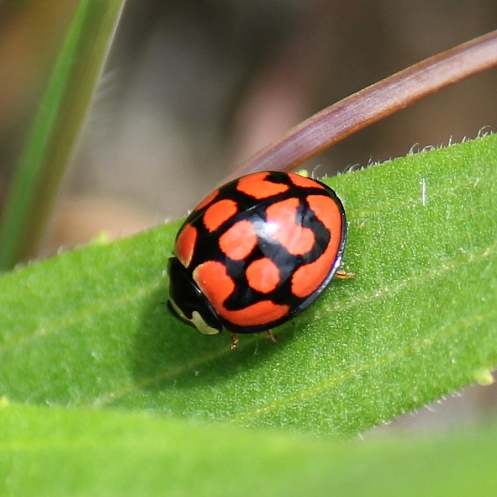
The Lunate Ladybird, Cheilomenes lunata, is one of my favourites, usually I see the exotic Ladybirds.
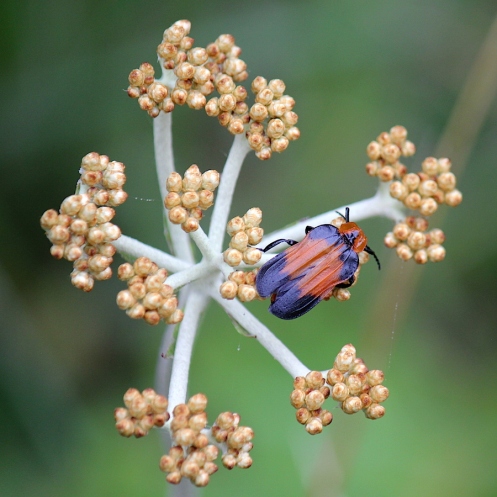
This stylish Net-winged Beetle, Family Lycidae, was settled on Helichrysum buds.
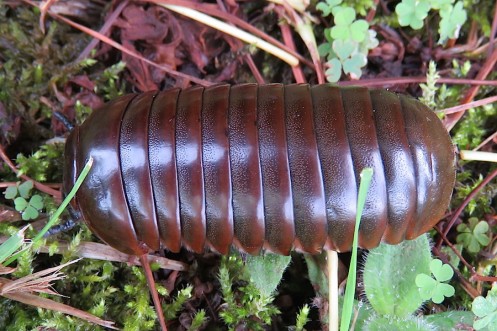

Pill millipedes fascinate me and I was delighted to have an opportunity to see it’s friendly face, often tightly hidden when they roll themselves into a pill ball.

A very cryptic Robberfly blended into the rock.

At the beginning of December I saw many Tri-coloured Tiger, Rhodogastria amasis, moth caterpillars,
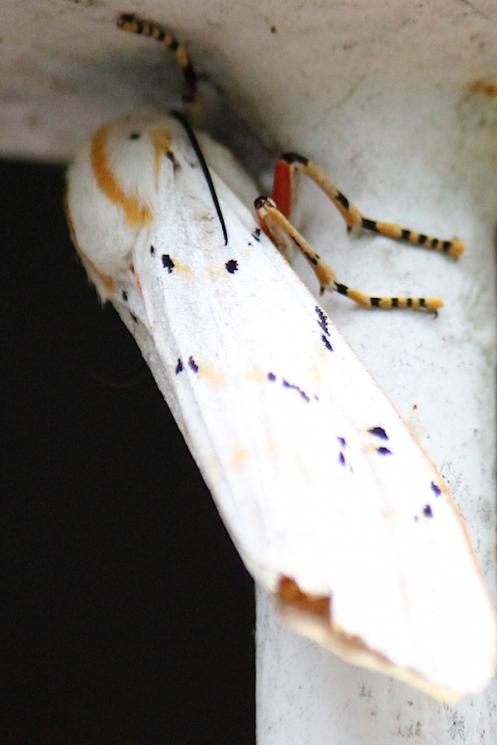
and then the other day I saw a moth.
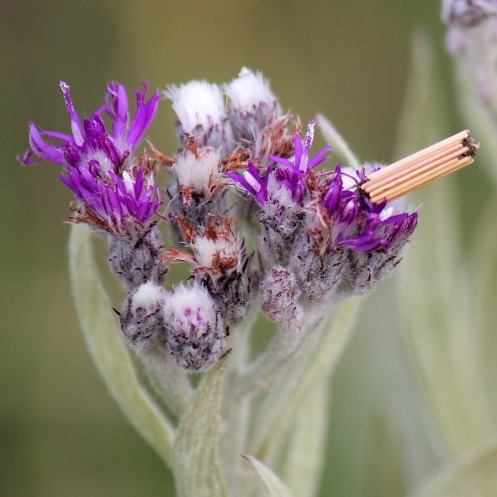
A very neatly constructed Bagworm, Family Psychidae of moths, jutted from a Vernonia flower.
There is lots of spider activity,

from the egg sac of a False button spider, Theridion, young emerged.
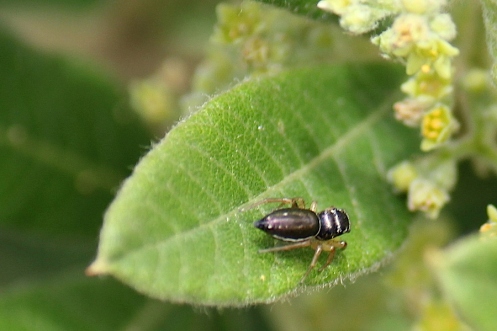
A delightful tiny spider sat sunning on a leaf.

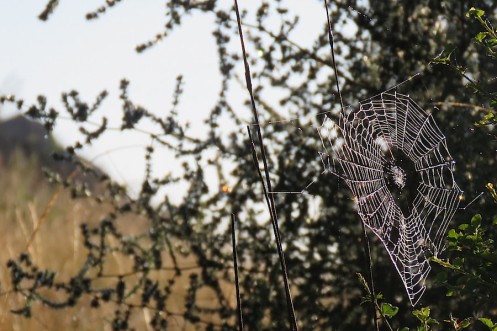
Webs of all kinds festoon branches and corners.
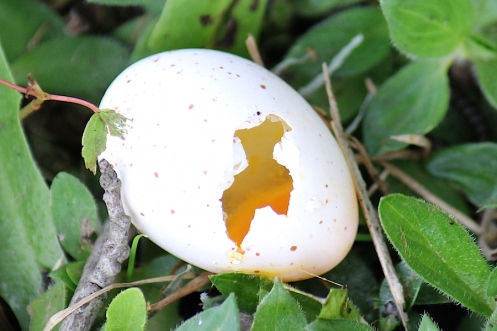
One morning after a windy storm this small broken egg lay beneath a tree, not sure which bird.

An African Stonechat,


Fork-tailed Drongo
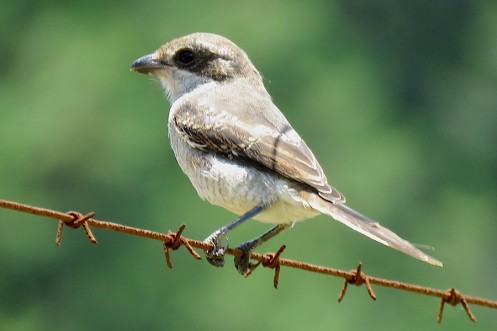
and a juvenile Fiscal use the fence to spot prey.
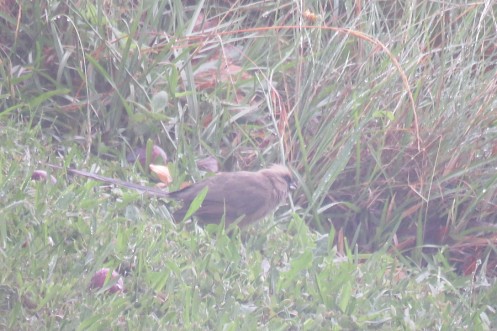
Speckled Mousebirds foraged for fallen plums in the mist.
A first sighting this month on our property was a Secretary Bird!
Two orchids were in flower;
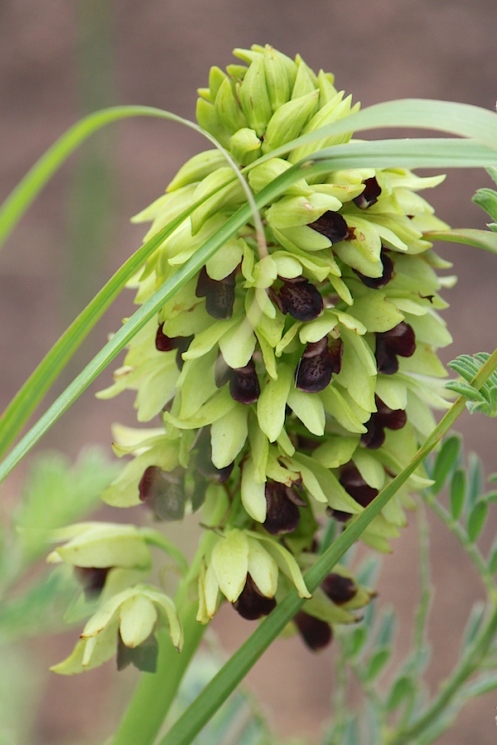
Orthochilus foliosus

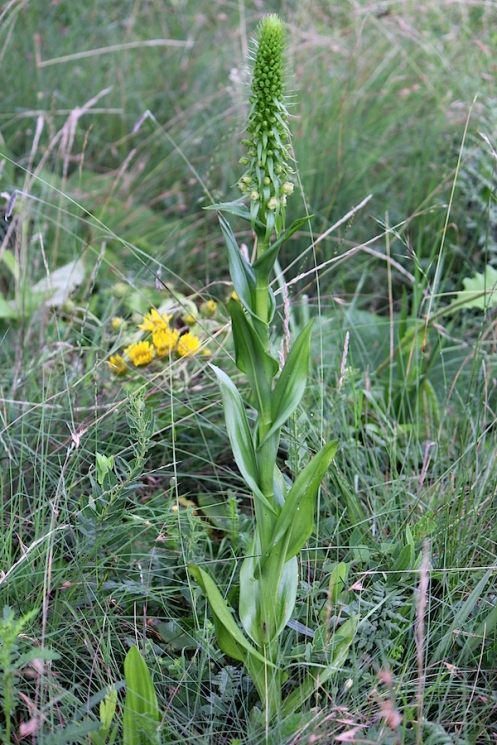
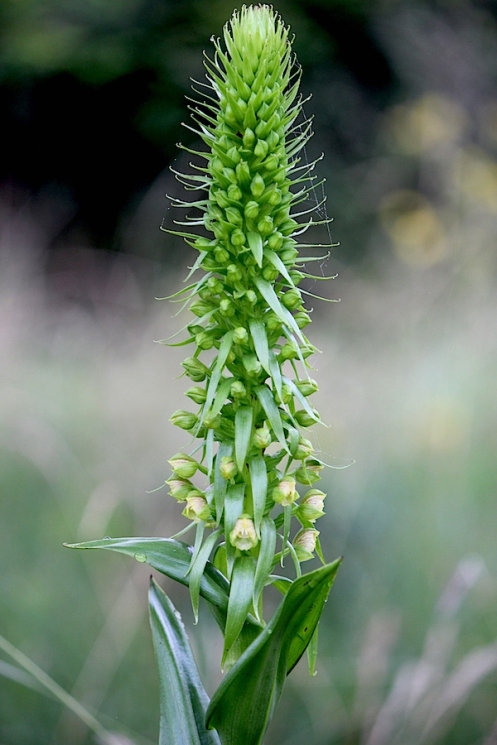
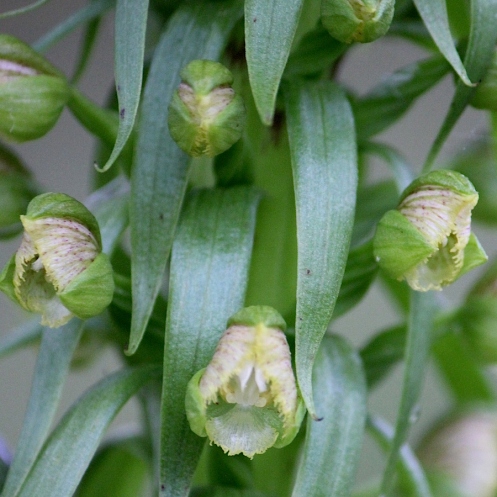
and for only the second time in 25 years I have watched a single Pterygodium magnum plant grow and develop an inflorescence which has just started opening.
Some of the other flowers seen and photographed are: 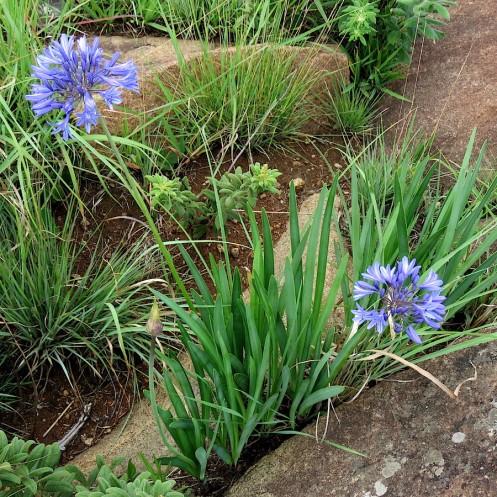
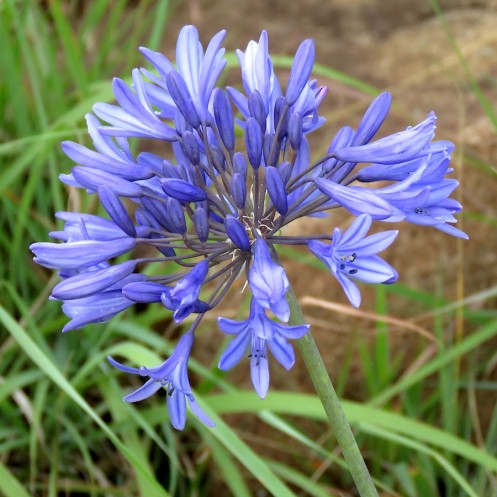
Agapanthus campanulatus;
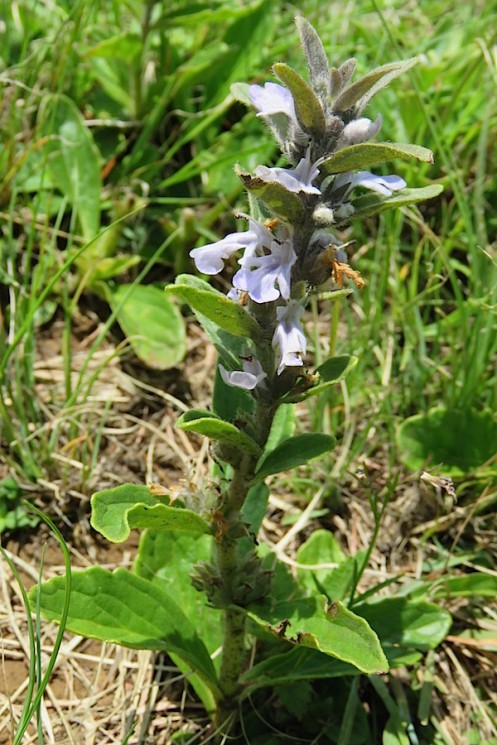
Ajuga ophrydis;

Ascelepias albens;
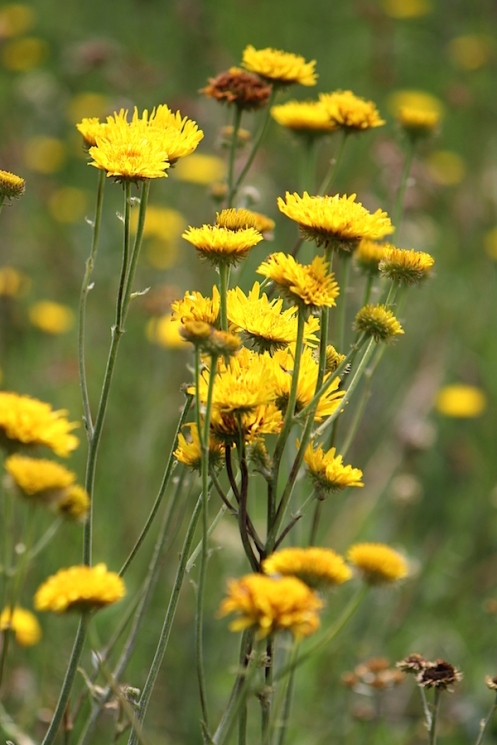
Berkheya setifera;

Craterocapsa tarsodes which I usually associate with higher parts of the Drakensberg;
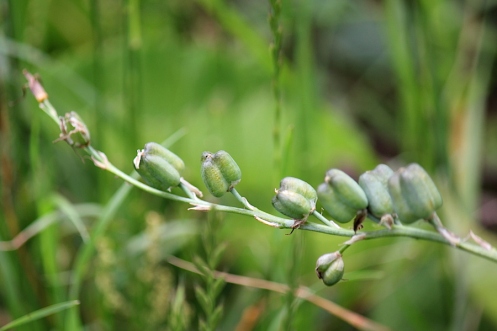
Dipcadi viride fruit;
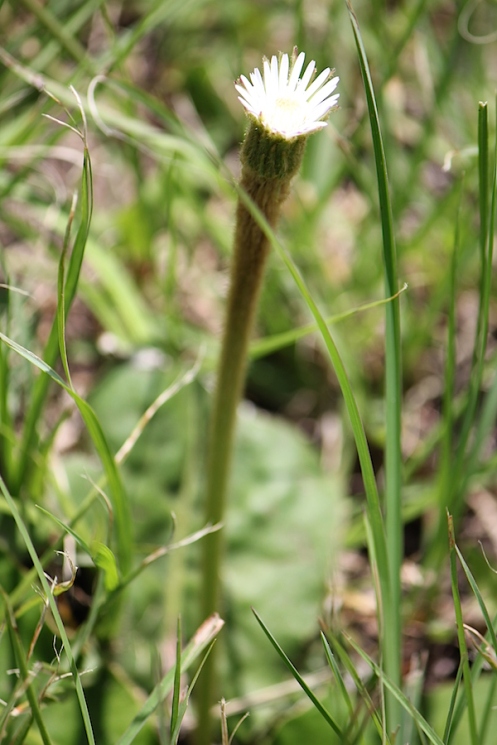
Gerbera piloselloides;

Hibiscus aethiopicus;
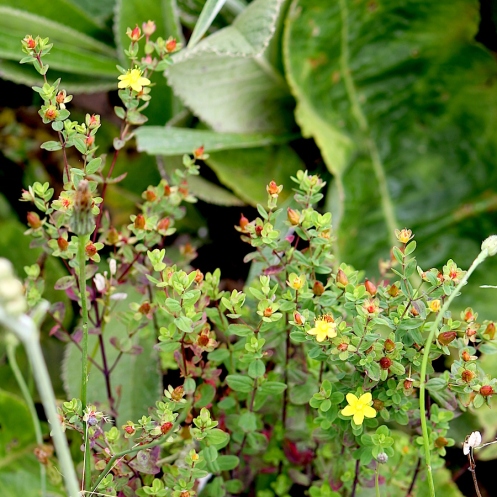
Hypericum aethiopicum;
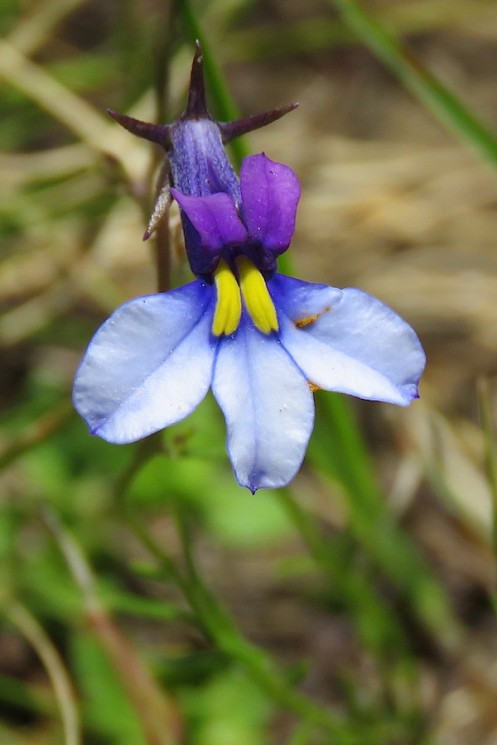
Monopsis decipiens;
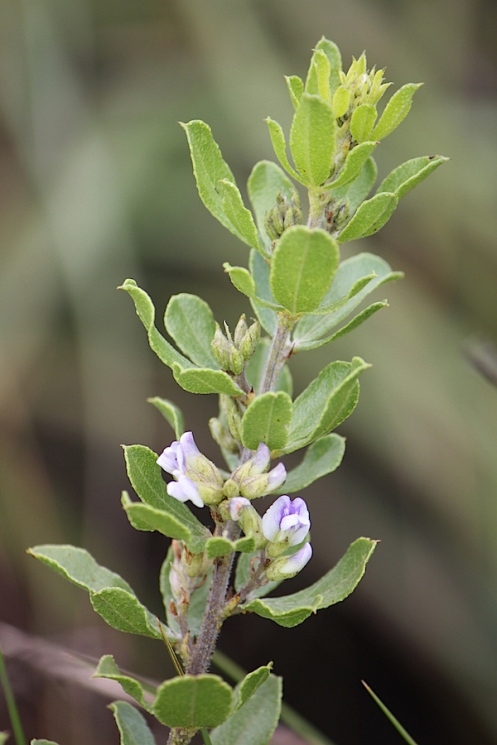
Otholobium polystictum;

Papaver aculeatum;

Pearsonia sessilifolia;
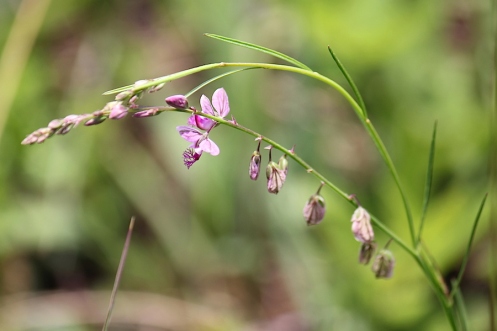
Polygala hottentotta;

Polygala refracta;

the last of the Watsonia socium;
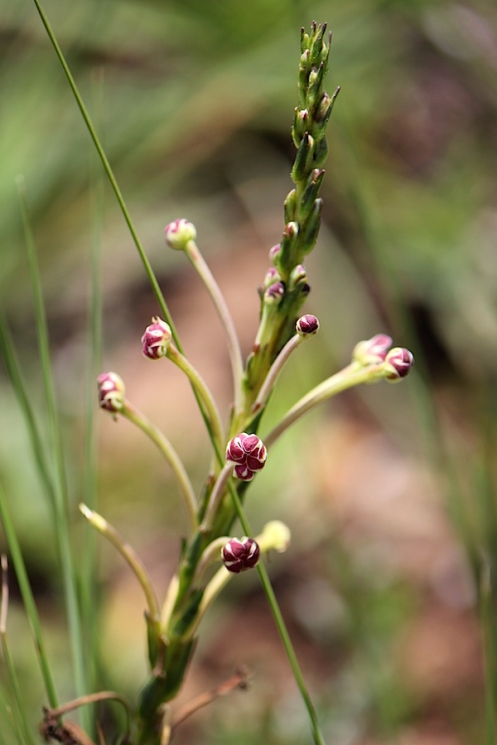
Zaluzianskya microsiphon
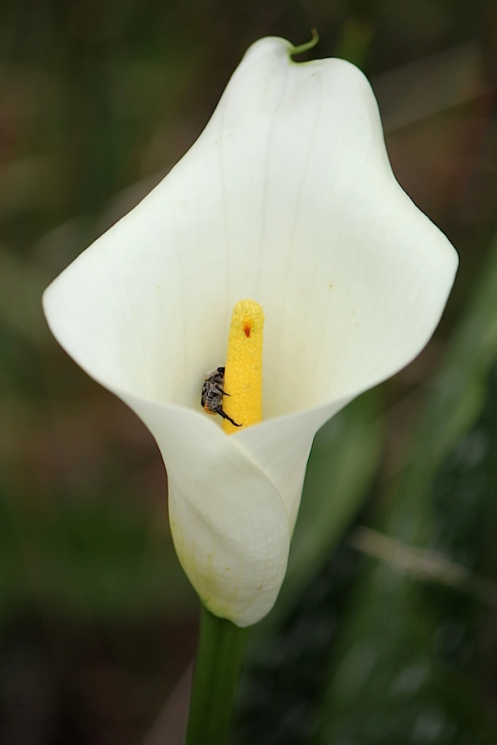
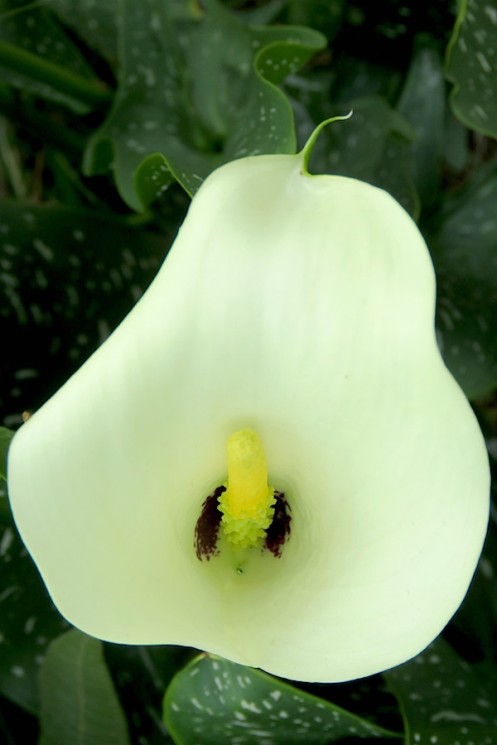
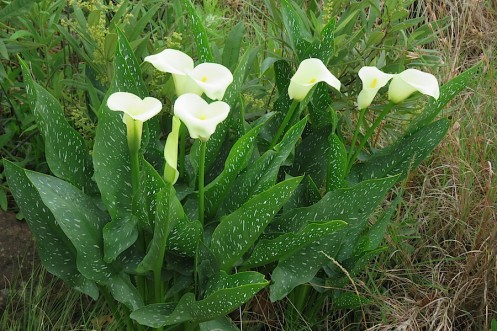
and Grassland Arums, Zantedeschia albomaculata, this is the clump that the Bushpig feasted on!
With the rain, fungi have appeared;
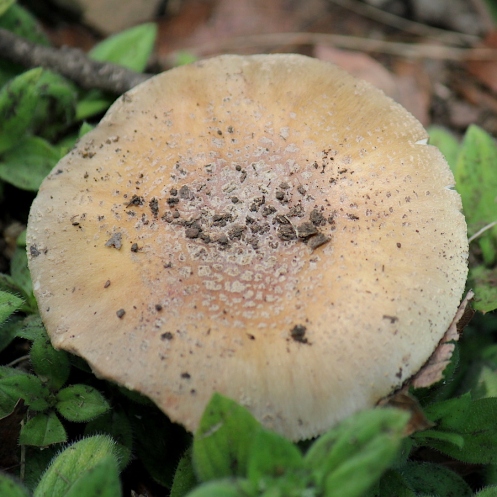
Amanita rubescens;
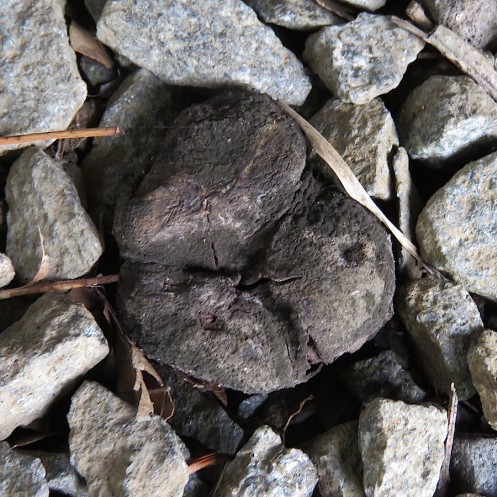
this dark solid fungi;
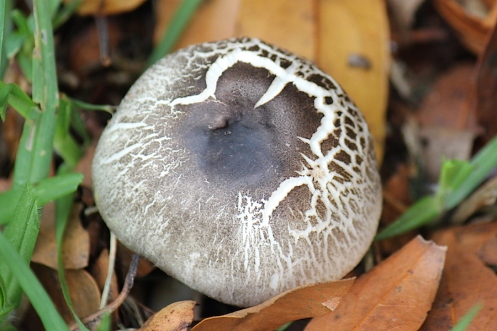
a beautiful mushroom, possibly of the Termitomyces species
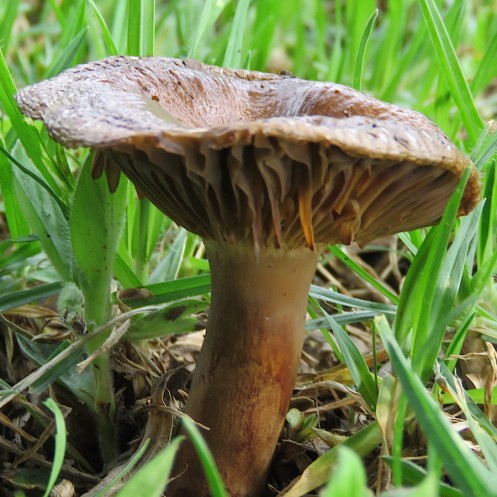
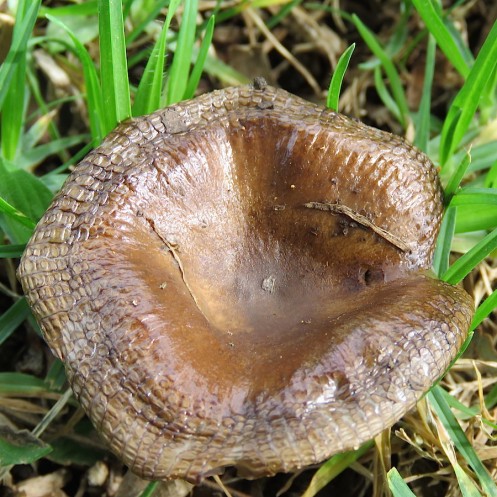
and possibly a Paxillus involutus.